After hundreds of years of Muslim incursions into formerly Christian territories, the West was finally aroused to resist. Kings, nobles, prelates, priests, monks, and commoners were almost always motivated by religious belief and zeal (albeit, perhaps mixed with more than a little bit of escapism and greed and self interest). But who were the motivators? Ultimately it may have been the Turkic leaders who were expanding Islamic suzerainty, but that alone didn't move anyone into action until besieged Byzantine emperors and somewhat threatened Catholic popes (the latter often working through charismatic preachers) got into the act.
This unit will look at the more important folks involved in the Second, Third, and Fourth crusades along with a few maps and illustrations to show where they were active.
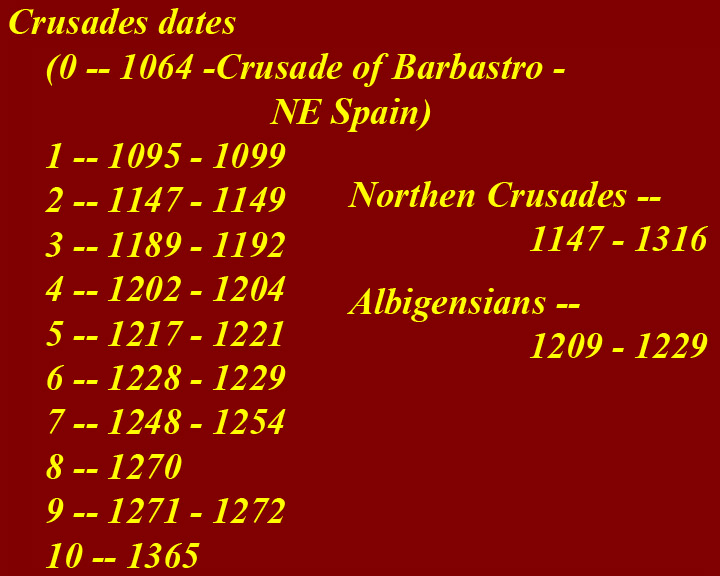
http://www.mmdtkw.org/CRUS0000CrusadesDates.jpg
Chronology of the Second Crusade and its Aftermath
From: http://atheism.about.com/library/FAQs/christian/blchron_xian_crusades05.htm
Second Crusade 1144 - 1150
December 24, 1144 Muslim forces under the command of Imad ad-Din Zengi re-capture Edessa, originally taken by Crusaders under Baldwin of Boulogne in 1098. This event makes Zengi a hero among Muslims and leads to a call for a Second Crusade in Europe.
1145 - 1149 The Second Crusade is launched to recapture territory recently lost to Muslim forces, but in the end only a few Greek islands are actually taken.
December 01, 1145 In the Bull Quantum Praedecessores, Pope Eugene III proclaims the Second Crusade in an effort to retake territory once again coming under the control of Muslim forces. This Bull was sent directly to the French King, Louis VII, and although he had been contemplating a Crusade on his own, he chose to ignore the pope's call to action at first.
1146 The Allmohads drive the Almoravids out of Andalusia. The descendants of the Amoravids can still be found in Mauretania.
March 13, 1146 Saxon nobles meeting in Frankfurt ask Bernard of Clairvaux for permission to launch a Crusade on pagan Slavs in the east. Bernard would pass the request along to Pope Eugene III who gives his authorization for a Crusade against the Wends.
March 31, 1146 St. Bernard or Clairvaux preaches the merits and necessity of the Second Crusade at Vézelay. Bernard writes in a letter to the Templars: "The Christian who slays the unbeliever in the Holy War is sure of his reward, the more sure if he himself is slain.The Christian glories in the death of the pagan, because Christ is thereby glorified." King Louis VII of France is particularly taken by Bernard's preaching and is among the first to agree to go, along with his wife Eleanor of Aquitaine.
May 01, 1146 Conrad III (first German king of the Hohenstaufen dynasty and uncle of Frederick I Barbarossa, an early leader of the Third Crusade) personally leads German forces into the Second Crusade, but his army would be almost completely destroyed during their crossing of the plains of Anatolia.
June 01, 1146 King Louis VII announces that France will join in the Second Crusade.
September 15, 1146 Imad ad-Din Zengi, founder of the Zengid Dynasty, is assassinated by a servant he had threatened to punish. Zengi's capture of Edessa from the Crusaders in 1144 had made him a hero among Muslims and led to the launching of the Second Crusade.
December 1146 Conrad III arrives at Constantinople with the remnants of his army of German Crusaders.
1147 The Almoravid (al-Murabitun) Dynasty falls from power. Taking the name "those who line up in defense of the faith," this group of fanatical Berber Muslims had ruled North Africa and Spain since 1056.
April 13, 1147 In the bull Divina dispensatione Pope Eugene III approves of the Crusading into Spain and the beyond the northeastern frontier of Germany. Bernard Clairvaux writes "We expressly forbid that for any reason whatsoever they should make a truce with these people [the Wends] ... until such time as ... either their religion or their nation be destroyed."
June 1147 German Crusaders travel through Hungary on their way to the Holy Land. On the way they would raid and pillage widely, causing a great deal of resentment.
October 1147 Lisbon is captured by Crusaders and Portuguese forces under the command of Don Afonso Henriques, first king of Portugal, and Crusader Gilbert of Hastings, who becomes the first Bishop of Lisbon. In the same year the city of Almeria falls to the Spanish.
October 25, 1147 Second Battle of Dorylaeum: German Crusaders under Conrad III stop at Dorylaeum to rest and are destroyed by Saracens. So much treasure is capture that the market price of precious metals throughout the Muslim world drops.
1148 Count Ramon Berenguer IV of Barcelona, with the aid of an English fleet, captures the Moor city of Tortosa.
February 1148 German Crusaders under Conrad III who had survived the Second Battle of Dorylaeum the previous year are massacred by the Turks.
March 1148 French forces are left in Attalia by King Louis VII who purchases passage on ships for himself and a few nobles to Antioch. Muslims quickly descend upon Attalia and kill nearly every Frenchman there.
May 25, 1148 Crusaders set out to capture Damascus. The army consists of forces under the command of Baldwin III, survivors of Conrad III's trip across Anatolia, and the cavalry of Louis VII which had sailed directly to Jerusalem (his infantry was supposed to march to Palestine, but they were all killed along the way).
July 28, 1148 Crusaders are forced to withdraw from their siege of Damascus after only a week, partly as a result of the three leaders (Baldwin III, Conrad III, and Louis VII) being unable to agree on almost anything. The political divisions among the Crusaders stand in sharp contrast to the greater unity among the Muslims in the region - a unity that would only increase later under the dynamic and successful leadership of Saladin. With this, the Second Crusade is effectively finished.
1149 A Crusading army under Raymond of Antioch is destroyed by Nur ad-Din Mahmud bin Zengi (son of Imad ad-Din Zengi, founder of the Zengid Dynasty) near the Fountain of Murad. Raymond is among those killed, reportedly fighting until the very end. One of Nur ad-Din's lieutenants, Saladin (Kurdish nephew of Nur al-Din's best general, Shirkuh), would rise to prominence in the coming conflicts.
July 15, 1149 The Crusader Church of the Holy Sepulcher is officially dedicated.
Aftermath of the Second Crusade
1150 Fatimid rulers fortify the Egyptian city of Ascalon with 53 towers.
1152 Baldwin III is crowned king of Jerusalem.
1152 King Henry II of England marries Eleanor of Aquitaine, thus gaining control of her lands in France. Eleanor would give birth to Richard the Lionheart, one of the leaders of the Third Crusade. She had previously been married to King Louis of France and her involvement in the Second Crusade was blamed by some for its failure.
March 04, 1152 Friedrich I Barbarossa, nephew of Conrad III, is elected German King in Frankfurt. He would later become Holy Roman Emperor.
1153 King Baldwin III of Jerusalem captures Ascalon after a siege of several months, thus drawing Egypt into an alliance with the Turks in Palestine. Reynald of Chantillon is named Prince of Antioch.
August 20, 1153 St. Bernard of Clairvaux dies. Bernard had founded the famous abbey at Clairvaux and was largely responsible for inspiring many Europeans to set off on the Second Crusade. The failures of the Second Crusade deeply troubled Bernard and he had blamed them on the sins of the Crusaders themselves.
April 25, 1154 Because European Crusaders had laid siege to the city in 1148 despite the existence of a truce with them, citizens of Damascus decide that the Crusaders could no longer be trusted and hand control over to Nur ad-Din Mahmud bin Zengi. In assuming control of this city, Nur ad-Din is able to unite all of Muslim Syria. One of Nur ad-Din's lieutenants, Saladin (Salah-al-Din Yusuf ib-Ayyub), would rise to prominence in the coming conflicts.
1155 King Baldwin III enters into an alliance with Byzantine Emperor Manuel I Comnenus in order to more effectively counter the growing threat from Nur ad-Din.
1156 Baldwin III signs a peace treaty with Nur ad-Din, but the following year he would break it and capture the city of Narim.
1156 Reynald of Chantillon, Prince of Antioch, launches an attack against Cyprus.
August 1157 A strong earthquake hits Syria. Through the previous couple of years, numerous earthquakes had been recorded all through the Levant.
September 08, 1157 Richard I Lionheart of England is born. Richard would be one of the leaders of the Third Crusade.
October 1157 Nur ad-Din is struck by a severe illness, halting his steady campaign against the Crusaders.
1158 Baldwin III defeats Seljuk ruler Nur ad-Din.
1160 Birth of Simon de Montfort, 5th Earl of Leicester and leader of the Crusade against the Cathars in southern France.
1160 Raymond of Chantillion is captured during a Muslim ambush and is imprisoned for 14 years in Aleppo. Once released, his hatred of Islam and Muslims would be even greater than before and would be instrumental in the Third Crusade being launched.
1161 First recorded use of explosives, in China, at the Battle of Ts'ai-shih.
February 10, 1162 King Baldwin III dies at Tripoli and control of Jerusalem passes to his brother, Amalric I. Amalric's chief goal is the conquest of Egypt and, in fact, his continual failure to capture Egypt may have been an important cause of the decline in power of the Latin Kingdom of Jerusalem.
1163 - 1169 Egypt and Jerusalem are in a constant state of war. During this time one of Nur ad-Din's lieutenants, Saladin (Salah al-Din), rises to prominence.
1163 Nur ad-Din lays siege the fortress of Krak des Chevaliers (headquarters of the Knights Hospitaller in Syria) but fails to take it.
September 1163 Amalric I, king of Jerusalem. launches his first invasion of Egypt. He manages to get as far as the Nile, but is turned back by the flooding.
May 1164 Shawar is reinstated as Vizier of Cairo with the help of Nur ad-Din Mahmud bin Zengi.
July 1164 A joint army of Egyptians and Franks besiege Shirkun in Bilbeis.
1165 Cathars have become so numerous in Languedoc that they are able to defy local prelates and meet at Lombers (Lombez) where there heretical doctrines are proclaimed openly.
August 21, 1165 Philip II Augustus of France is born. Philip would be one of the leaders of the Third Crusade.
1166 Saladin orders the construction of fortifications in Cairo which become known as "The Citadel."(Saladin is also credited with building the present walls of the "old city" of Jerusalem.)
1167 Papa Nicetas, a Bogomil heretic from the east, attends an assembly of Cathars leaders in Languedoc at Saint-Felix-de-Caraman (near Toulouse).
1167 Amalric I launches his second of three unsuccessful invasions of Egypt, although he briefly captures the city of Cairo. This same year he marries Maria Comnena, grand-niece of Byzantine emperor Manuel I Comnenus.
1168 Arab forces recapture Cairo from the Crusaders.
1168 - 1250 The Ayyubid dynasty, founded by Salah-al-Din Yusuf ib-Ayyub, rules Egypt.
October 10, 1168 Amalric I launches his third of three unsuccessful invasions of Egypt. This is a joint project with Byzantine Emperor Manuel I Comnenus Megas.
November 01, 1168 Amalric I, King of Jerusalem. massacres the inhabitants of Bilbeis, a fortress city on the eastern edge of the southern Nile delta in Egypt. The harsh treatment of locals manges to turn most Egyptians against the Crusaders, even the Coptic Christians who might have otherwise provided valuable aid and intelligence.
1169 Christians complete the reconstruction of the Church of Nativity in Bethlehem.
January 02, 1169 Amalric I, King of Jerusalem. leaves Egypt before Shirkuh and a Syrian army arrive.
January 08, 1169 Shirkuh, chief advisor and general for Nur ad-Din and Saladin's uncle, enters Cairo.
January 17, 1169 Vizier Shawar of Cairo is killed and Saladin takes control of both the city and Egypt.
November 1169 A Byzantine fleet and army attack Damietta, but they are forced to withdraw without accomplishing anything.
1170 Saladin captures the Crusader-controlled city of Eilat, located on the Red Sea.
1171 In the bull Non parum animus noster, Pope Alexander III equates Crusades against pagan Estonians and Finns in the north with Crusading in the Holy Land: "We therefore grant to those who fight with might and courage against the aforesaid pagans one year's remission for the sins they confess and receive penance for, trusting in God's mercy and the merits of the apostles Peter and Paul, just as we usually grant to those who visit the Sepulcher of the Lord; and if those who perish in the fight are doing their penance, to them we grant remission of all their sins."
1171 Battle of Santarem: The last battle that drives the Muslims out of Portugal.
March 12, 1171 For a time Byzantine emperor Manuel ends Venetian commercial privileges in Constantinople, a factor that would eventually play in Venice's decision to have the armies of the Fourth Crusade conquer and loot the city. Every Venetian in the empire is arrested and all of their property is confiscated. In retaliation, Venetian ships sack the Byzantine islands of Chios and Lesbos.
June 1171 Under orders from Nur ad-Din, Saladin removes the last Fatimid Caliph from power. The Caliph of Egypt would eventually die and the Caliph of Baghdad would be recognized in Egypt.
September 10, 1171 Saladin announces the formation of the Abbasid Caliphate in Egypt.
1173 Saladin launches an attack on the Fortress of Kerak but fails.
1174 King Henry II of England is forced to humble himself at the grave of Thomas Becket, canonized the year before. As part of his penance for his complicity in Becket's murder, Henry is required by Pope Alexander III to send twice a year enough funds and supplies to support 200 Templar and Hospitaller knights in the Holy Land. This support would end up playing an important role in financing the Third Crusade.
January 81, 1174 Bernard of Clairvaux is canonized.
May 15, 1174 Nur ad-Din Mahmud bin Zengi dies. Saladin would eventually take over for him, controlling a Muslim empire that stretches from the Tigris river to the Libyan desert and surrounding the Crusader states on three sides. First, though, Saladin had to defeat ed-Din's son As-Salih Ismail.
July 11, 1174 Amalric I, king of Jerusalem. dies and is succeeded by his son, Baldwin IV. Baldwin, unfortunately, is only thirteen years old and had been showing signs of leprosy since he was nine - so no one was very confident that he would be able to truly take control of the kingdom.
September 1174 Count Raymond of Tripoli is named regent of the Kingdom of Jerusalem. Raymond is not a popular choice. Although supported by many barons, the Hospitallers, and others, he is opposed by the Templars and other influential families like the Lusignans. These divisions would plague the Crusaders states and contribute to their eventual downfall.
October 28, 1174 Saladin captures Damascus and becomes the ruler of both Egypt and Damascus.
1175 Byzantine emperor Manuel I Comnenus fortifies the Anatolian city of Dorylaeum.
1175 Reynald of Châtillon and Joscelin of Courtenay are released by the atabeg of Aleppo. The atabeg was grateful to the Christian Crusaders because they had come to his aid against Saladin. Opposition to Count Raymond of Tripoli coalesces around Reynald and Joscelin.
1176 Battle of Myriocephalum: Muslims defeat the Byzantines under Manuel I Comnenus Megas and capture the city of Dorylaeum.
August 1176 Saladin besieges the city of Masyaf.
1177 Sibylla, sister of leper king Baldwin IV and daughter of Amalric I, is married to William of Montferrat. William, however, dies shortly thereafter due to malaria.
November 18, 1177 Saladin leaves Egypt in the hope of quickly capturing Jerusalem from the Crusaders. A small force of Knights Templar are kept pinned down so that the main army can continue northward.
November 25, 1177 Battle of Ramleh (Montgisard): Although a force of 500 led by King Baldwin IV attempts to stop Saladin at Ascalon, the same site where an Egyptian relief force was defeated almost one hundred years before, the Egyptian army is able to bypass the Crusaders and continue on towards the goal of Jerusalem. Baldwin is able to join up with the Templars from Gaza, however, and surprise Saladin from the rear. The Egyptian army is routed and Saladin himself barely escapes. Luckily for Saladin, the Crusaders were unable to seriously press their unexpected advantage and threaten his holdings in Damascus or Egypt.
1179 Saladin defeats Crusader forces at Marj Ayun (Valley of the Springs), capturing the Master of the Knights Templar in the process.
1180 Meinhard, an Augustinian monk from Holstein, leads the first attempt to convert Baltic pagans in what most regard as the first steps of the Baltic Crusades.
March 1180 Sibylla, sister of King Baldwin IV, marries Guy De Lusignan. King Baldwin also negotiates a peace treaty with Saladin, bringing hostilities to a temporary end. Reynald of Châtillon throws his support behind Guy for the throne of Jerusalem and against Raymond of Tripoli, regent of Jerusalem.
September 18, 1180 Death of French King Louis VII, one of the leaders of the Second Crusade.
September 24, 1180 Death of Manuel I Comnenus Megas, Byzantine Emperor. Manuel had let the armies of the Second Crusade pass through his lands on their way to Palestine, but during much of his reign he was at war with various European powers like the Normans and Venice. Manuel is succeeded by his son Alexius II, just eleven years old. Manuel's wife, Maria, is Latin by birth and greatly resented among the people, leading to an insurrection two years later.
1181 Al-Salih Ismail, heir of Nur ad-Din, dies. This allows Saladin to complete his take-over of ad-Din's empire.
1181 Reynald of Châtillon raids a large caravan of pilgrims on their way to Mecca. The violates a peace treaty which outrages Saladin.
1182 Andronicus Comnenus leads an insurrection against empress Maria, killing many Italian merchants as well as the young Alexius II, heir to the throne of the Byzantine empire. Andronicus becomes a ruthless leader, killing large numbers of alleged rivals and dissenters.
May 11, 1182 Saladin sets out from Cairo with a large Muslim army. His intention is to link up with other Muslim forces elsewhere, gathering enough soldiers under his immediate command to put an end to the Crusader states once and for all.
1183 Reynald of Chantillon, Prince of Antioch, launches a military expedition down the Red Sea. His intention is to invade Arabia and travel to Mecca where he would destroy Muhammed's tomb and smash the Kaaba. He takes with him a small force, lands at el-Haura, and is surprised by an Egyptian group that had been marching to Mecca already. Only a few, including Reynald, manage to escape.
1183 Saladin captures the city of Aleppo.
September 17, 1183 Saladin leaves Damascus with a large Muslim army and heads for the Crusader states. He meets the Crusader forces at the Pools of Goliath but the Christians retreat to Jerusalem. Guy of Lusignan's decision to withdraw here causes him to lose the confidence of other Christian leaders who now come to believe that he is indecisive at best, but more likely a coward.
1184 Meinhard oversees the building of the Christian church built in the Baltic region: the village of Uexküll (in modern-day Latvia).
1184 Saladin launches a second attack on the Fortress of Kerak, but fails again.
1184 Isaac Comnenus takes control of Cyprus. Isaac is a great-nephew of Manuel I and had launched a rebellion against the harsh rule of Byzantine emperor Andronicus, establishing an independent kingdom in Cyprus. Constantinople is far too weak to crush this rebellion and Isaac would hold on to power for 7 years.
1185 - 1195 Isaac II Angelus becomes Byzantine emperor. Andronicus Comnenus had ordered him arrested and killed, but his years of heavy-handed rule had taken their toll and the people refused. Isaac is made emperor by popular acclamation and Andronicus is forced to flee, but he is captured and killed by a mob. Isaac would not be as ruthless as Andronicus, but at the same time Isaac would be far more corrupt.
March 1185 King Baldwin IV dies of leprosy and King Baldwin V, still an infant, succeeds him as King of Jerusalem. Raymond of Tripoli is named regent.
August 1185 Normans lay siege to and sack Thessalonica, a Greek Christian city.
December 06, 1185 Death of Afonso I Henriques of Portugal in Coimbra. The first king of Portugal, Alfonso had created the nation of Portugal by liberating it from Muslim invaders and attempts at dominance from Castile in Spain.
1186 Meinhard is consecrated as the first Bishop of Buxtehude (Uexküll).
1186 Reynald of Chantillon breaks a truce with Saladin by attacking a Muslim caravan and taking several prisoners, including a sister of Saladin. This infuriates the Muslim leader who vows to kill Reynald with his own hands.
March 03, 1186 The city of Mosul, Iraq, submits to Saladin.
August 1186 Baldwin V, young king of Jerusalem. dies of an illness. His mother, Sibylla, sister of King Baldwin IV, is crowned Queen of Jerusalem by Joscelin of Courtenay and her husband, Guy of Lusignan, is crowned King. This is contrary to the previous king's will. The forces of Raymond of Tripoli are based in Nablus and Raymond himself is in Tiberias; as a consequence, the entire kingdom is effectively split in two and chaos reigns.
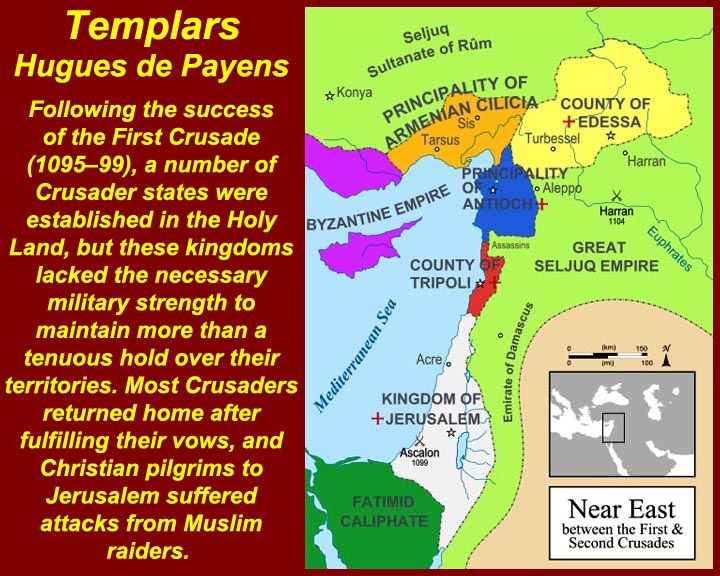
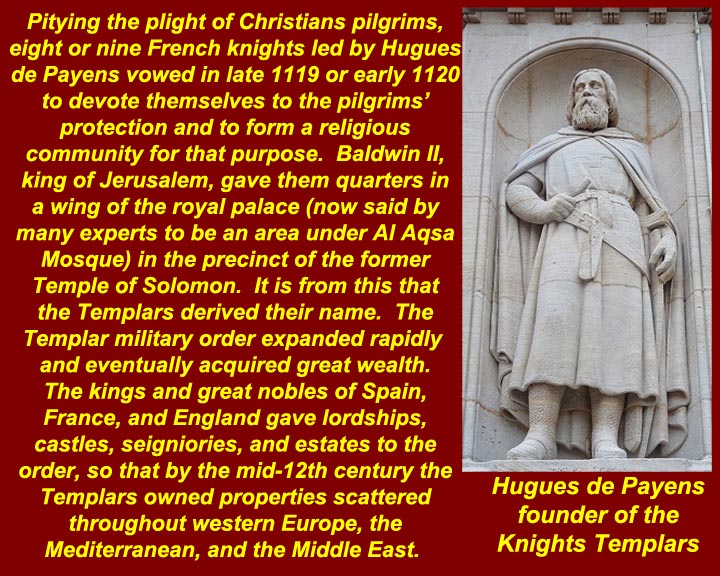
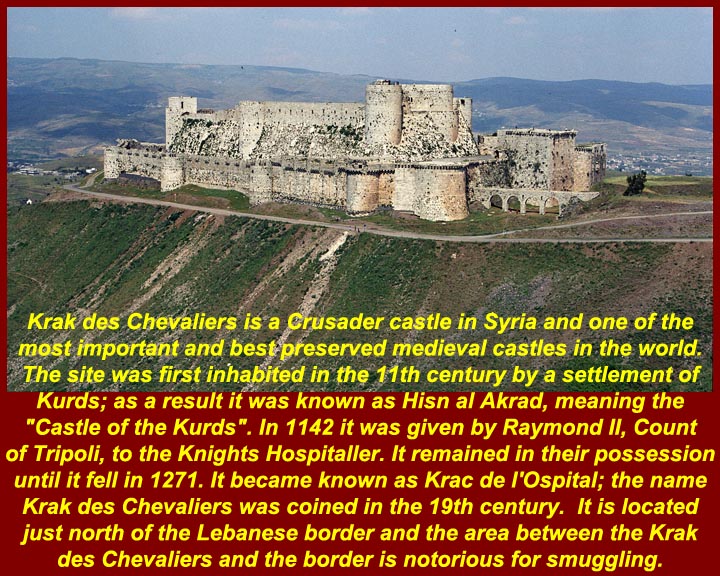
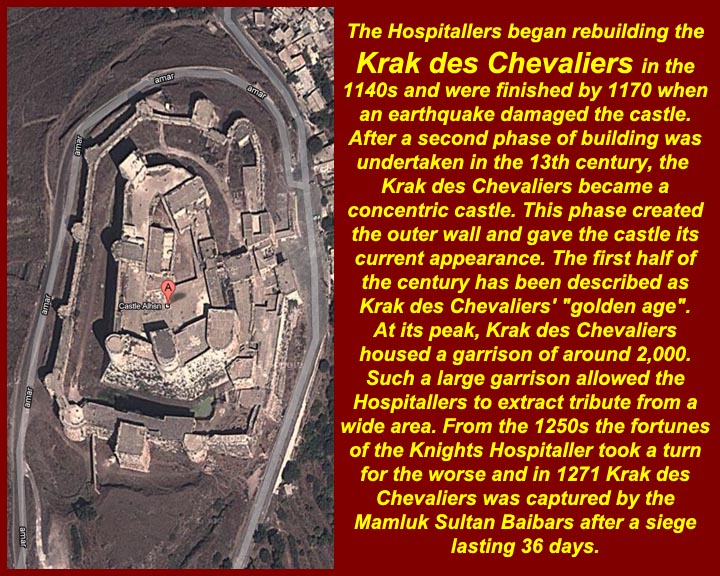
http://www.mmdtkw.org/CRUS0228b-HuguesDePayens-Templar.jpg
http://www.mmdtkw.org/CRUS0228c-HuguesDePayens-Templar1070-1136.jpg
http://www.mmdtkw.org/CRUS0228d-Krak_des_chevaliers1.jpg
http://www.mmdtkw.org/CRUS0228e-Krak_des_chevaliers2.jpg
Templars: After the First Crusade, the newly formed crusader states were barely able to hold their own core areas and definitely were not able to provide protection for Christian pilgrims in the Muslim controlled hinterland through which the pilgrims had to pass on their way to Jerusalem. In late 1119 or early 1120, a few French knights led by Hugues de Payens formed a military order to protect the travelers. Baldwin II, the King in Jerusalem billeted knights in a palace wing or outbuilding, which many experts now say was a space below the Al-Agsa Mosque, in the precinct of the former Temple of Solomon. It is from the Temple association that the Knights derived their name. The Knights Templar lasted for several centuries in the Middle East and reached their peak when their headquarters was in the Krak des Chevaliers, now in Syria just a few miles north of the Lebanese border. They were later suppressed and its Grand Master, Jaques Demolay was burned at the stake in 1314..
Masonic connections are unproven, and, in particular the Freemasonry Knights Templar acknowledge that all they take from the medieval order is their name and that "THERE IS NO PROOF OF DIRECT CONNECTION BETWEEN THE ANCIENT ORDER AND THE MODERN ORDER KNOWN TO DAY AS THE KNIGHTS TEMPLAR". (From http://www.knightstemplar.org.)
For information on the Templars, see http://www.newadvent.org/cathen/14493a.htm (for the Catholic side of the story) and http://en.wikipedia.org/wiki/Knights_Templar. The Wikipedia page is fairly straightforward, but follow-on links have some more esoteric versions. Reader beware: there's much misinformation about the Templars on the Internet; seing it on the net or on TV does not make it true..
Second Crusade 1145 - 1149: The less complicated organization of the Crusader forces and leadership of two kings should have worked in favor of the Crusaders, but by the time of the Second Crusade, the Turks had achieved a semblance of unity under Imad ad-Din Zengi. The result of the unity of the Crusaders' enemies was total failure of the Crusade.
Summaries:
http://en.wikipedia.org/wiki/Second_Crusade
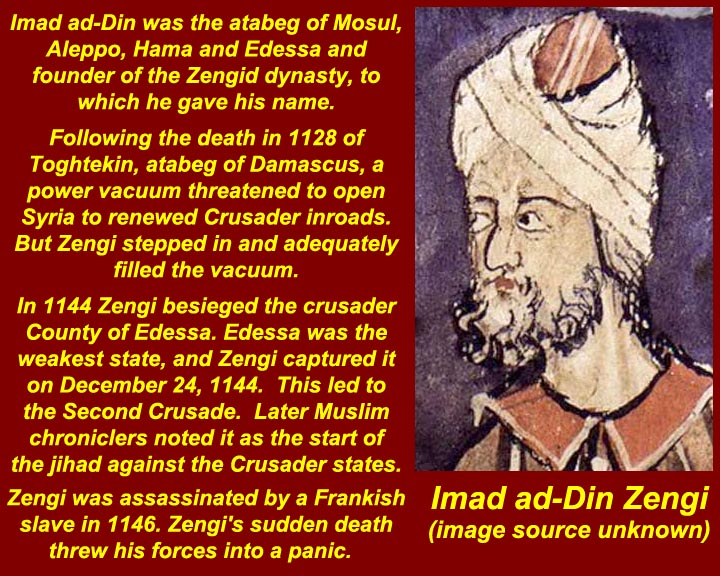
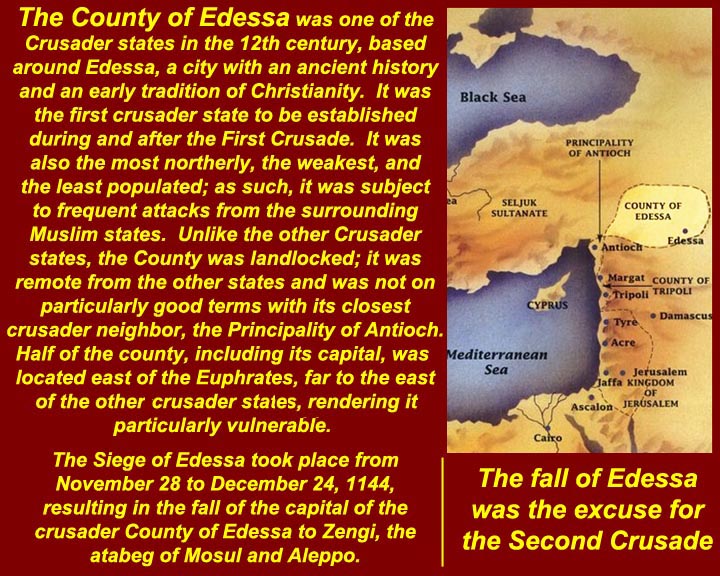
http://www.mmdtkw.org/CRUS0229-ImadAdDinZengi.jpg
http://www.mmdtkw.org/CRUS0230-EdessaFall2ndCrusade.jpg
Imad ad-Din Zengi captured Edessa from the Crusaders on Christmas Eve of 1144 setting in motion calls for the Second Crusade. Islamic historians count the date as the start of the jihad against the Crusader states.
For more information on Imad ad-Din, see http://en.wikipedia.org/wiki/Imad_ad-Din_Zengi.
For information on Edessa, see http://en.wikipedia.org/wiki/Edessa and http://www.newadvent.org/cathen/05282a.htm
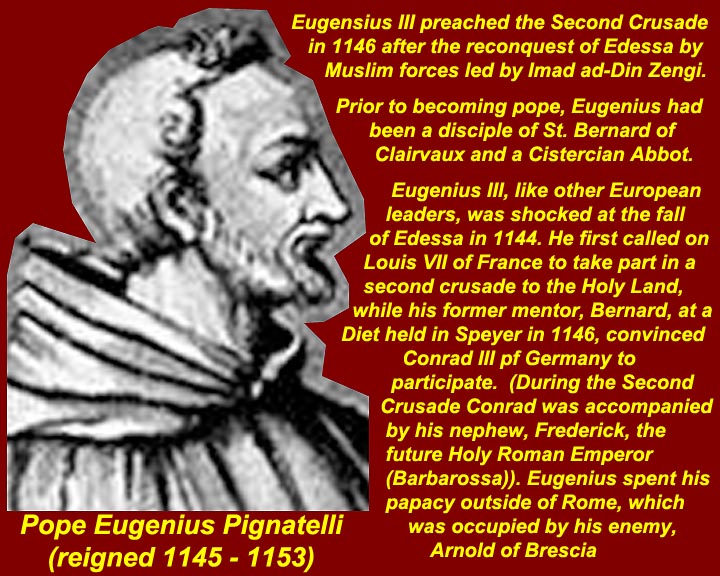
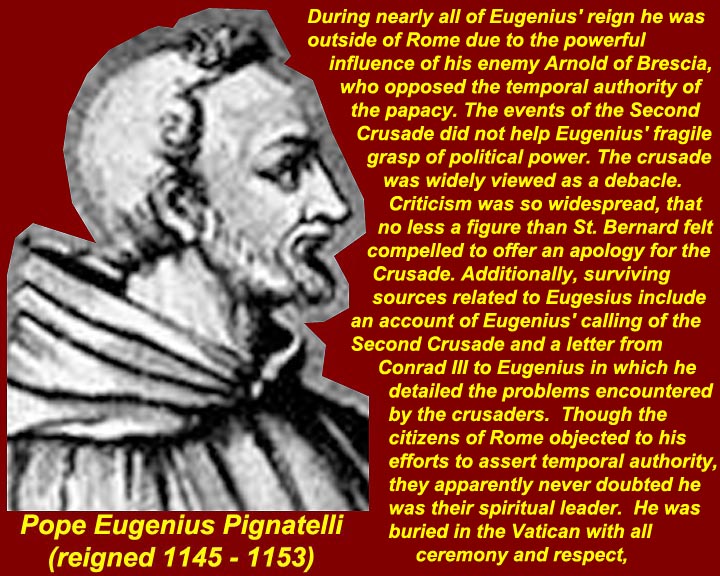
http://www.mmdtkw.org/CRUS0231a-EugeneIIIPignatelli1.jpg
http://www.mmdtkw.org/CRUS0231b-EugeneIIIPignatelli2.jpg
Pope Eugenius (Eugene) III reacted to the fall of Edessa by calling for a Second Crusade. Shocked European leaders quickly signed on.
For more information on Eugenius, see http://en.wikipedia.org/wiki/Pope_Eugene_III and http://www.newadvent.org/cathen/05599a.htm, and, for his call for the Second Crusade, http://www.fordham.edu/halsall/source/eugene3-2cde.asp.
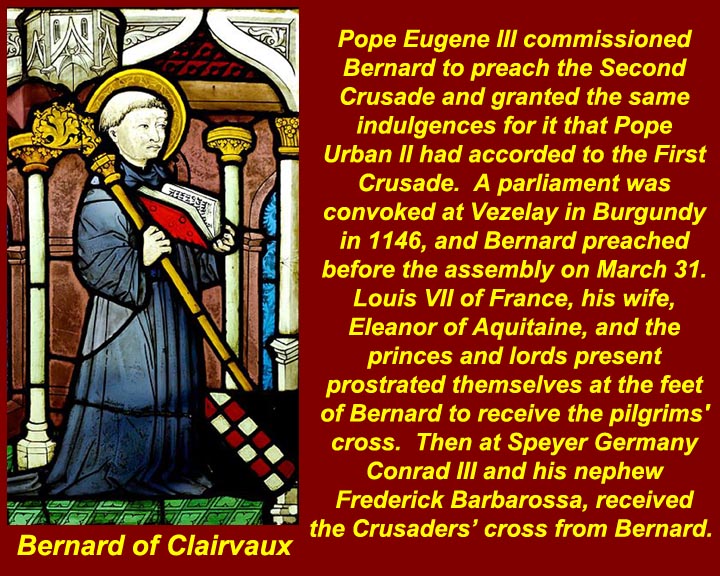
http://www.mmdtkw.org/CRUS0232-BernardOfClairvaux.jpg
Eugenius asked his old mentor and Abbot, (Saint) Bernard of Clairvaux, to preach the Second Crusade at a meeting at Vezelay in Burgundy on March 31, 1146. Louis VII of France, his wife Eleanor of Aquitaine, and princes and lords took the cross. Later, at Speyer on Germany, Conrad III and his nephew, Frederick Barbarossa, were inducted by Bernard. This was the first time that reigning monarchs went on Crusade. (Note: This is not the St. Bernard of the dogs, the Alpine pass, and the hospice in the pass. That was another Bernard, (Saint) Bernard of Menthon.)
For Bernard of Clairvaux, see http://en.wikipedia.org/wiki/Bernard_of_Clairvaux and http://www.newadvent.org/cathen/02498d.htm.
For Bernard of Menthon, see http://en.wikipedia.org/wiki/Bernard_of_Menthon.
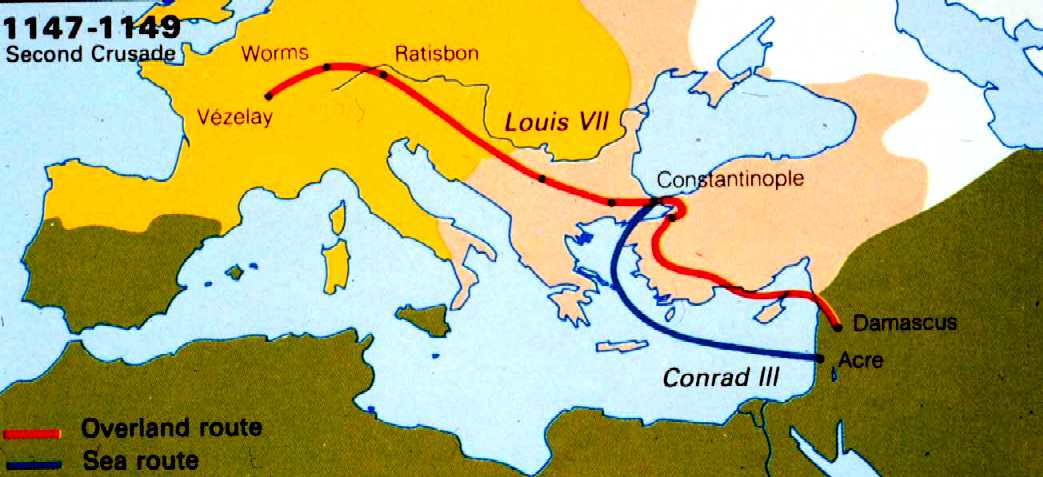
Map from http://www.medievaltymes.com/courtyard/second_crusade.htm, which also has much more information on the Crusade.
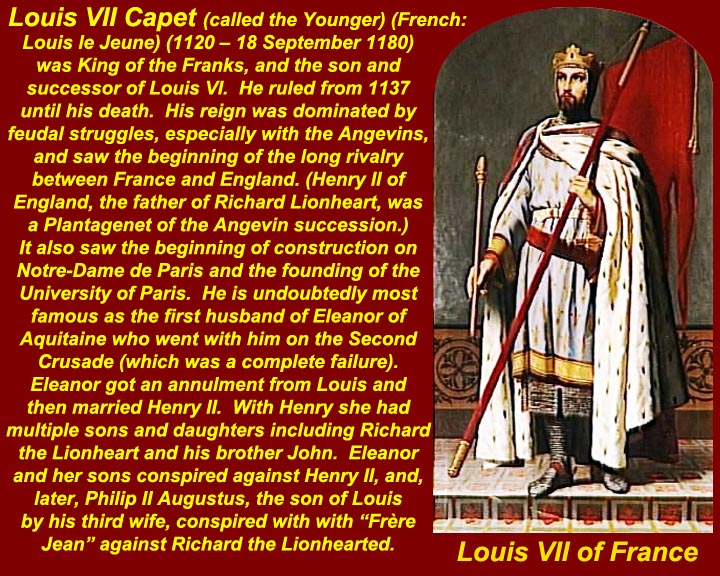
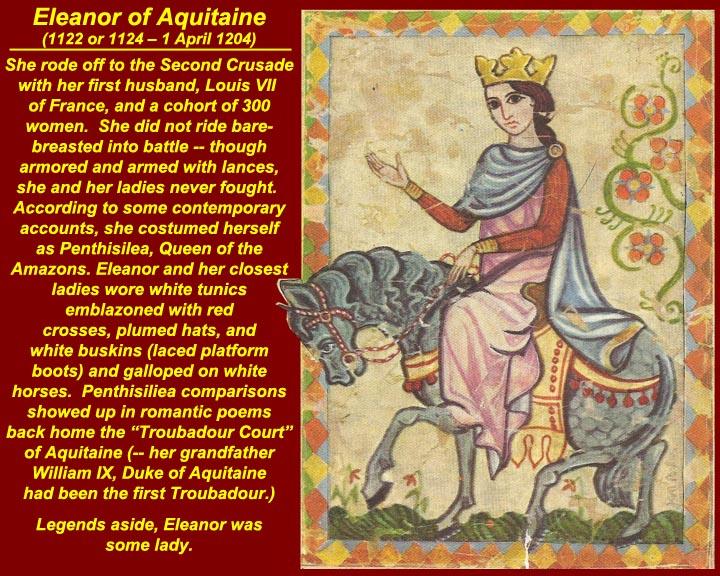
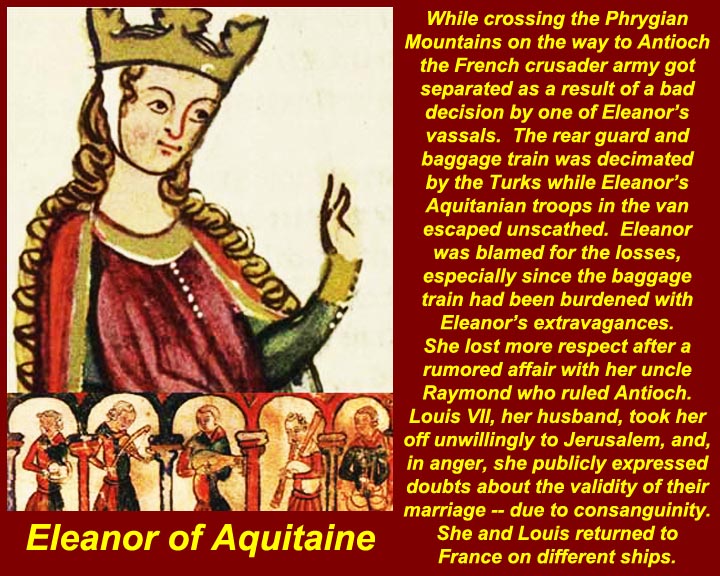
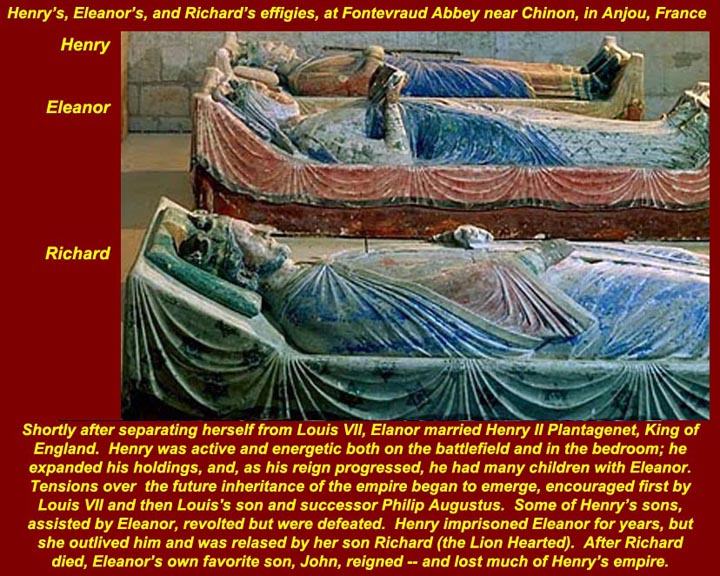
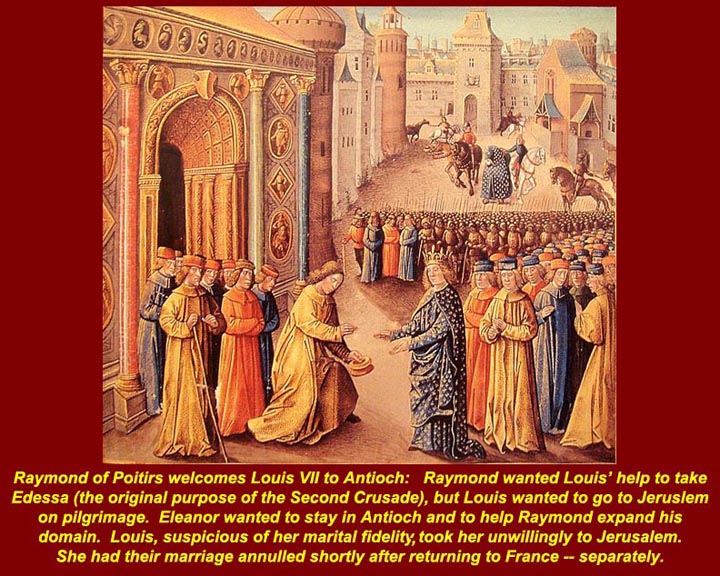
http://www.mmdtkw.org/CRUS0233-LouisVIIFrance.jpg
http://www.mmdtkw.org/CRUS0234-EleanorAquitaine1122-1204.jpg
http://www.mmdtkw.org/CRUS0235-Eleanor31.jpg
http://www.mmdtkw.org/CRUS0236-EleanorHenryRichard.jpg
http://www.mmdtkw.org/CRUS0238-RaymondPoitiersLouisVIIAntiocl.jpg
Louis VII was one of two Kings who led the Second Crusade, the purpose of which was to recapture Edessa. In the event, the Crusaders never even got to Edessa. Of the huge armiest that set out from Europe, only a few thousands escaped annihilation in Asia Minor at the hands of the Turks. Louis and Conrad, with the remnants of their armies, made a joint attack on Damascus, but had to raise the siege after a few days. This closed the crusade. Louis would not have been anything but a footnote except for the fact that he married Eleanor of Aquitaine, who was some lady. She grew up in the Aquitaine Troubadour Court of her Grandfather William IX, married Louis, and rode of to the crusade with an entourage of three hundred women. She and her women apparently did not ride bare breasted (disappointment!), but their Amazon costumes did provoke comment. There were rumors she had an affair with her uncle Raymond in Antioch where he ruled. Her jealous husband dragged her off unwillingly to Jerusalem. Harsh words were exchanged, and they went home to France on different ships. Shortly thereafter, she arranged an annulment from Louis and then eight weeks later married Henry II of England. With Henry she produced a number of sons, two of whom, Richard Lionheart and John Lackland, succeeded Henry II in turn as English kings.
Read about Louis VII at https://en.wikipedia.org/wiki/Louis_VII_of_France and http://www.nndb.com/people/027/000093745/.
Read about Louis' much more interesting wife, Eleanor, at http://en.wikipedia.org/wiki/Eleanor_of_Aquitaine and http://www.womeninworldhistory.com/heroine2.html (with links to other Internet sites) and http://womenshistory.about.com/od/medbritishqueens/p/eleanor_aq.htm (with links to other Internet sites).
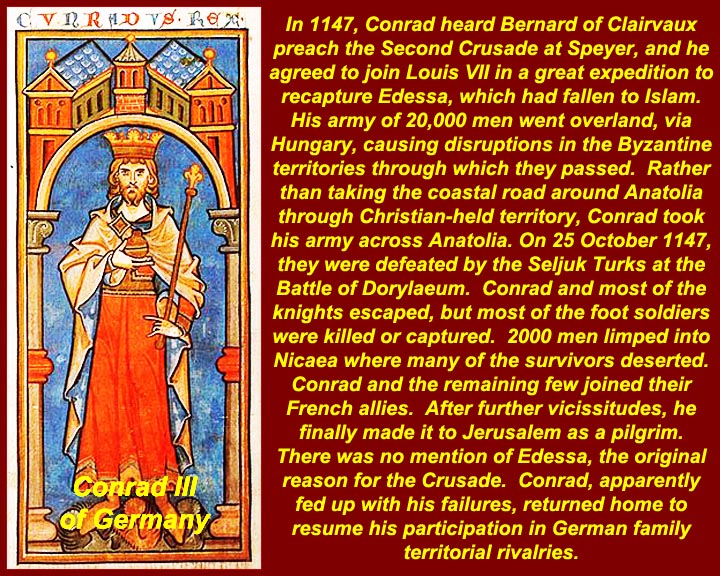
http://www.mmdtkw.org/CRUS0237-Conrad3OfGermany.jpg
The 20,000 man army of Conrad III went overland through Hungary and then disrupting Byzantine territories as they progressed. Rather than taking the Coastal road around Anatolia (through Christian held territories) Conrad led his army into the interior. They only got as far as Dorylaeum where they were annihilated by the Seljuk Turks led by Mesud I on October 25, 1147. The Germans were unable to continue the Crusade, and Conrad made his way (with his remaining 2,000 men - ten percent of his 20,000) to the army led by Louis VII of France. Conrad finally made it to Jerusalem as a pilgrim. But then, after participating in an abortive attack on Ascelon, Conrad abandoned his Crusade and went back to Germany. Neither he nor Louis had even tried to recapture Edessa. The Second Crusade was a complete failure.
----------------------------------------------------------------------------
Third Crusade 1189-1192
Summaries:
http://www.middle-ages.org.uk/the-third-crusade.htm
http://www.crusades-encyclopedia.com/primarysourcesthirdcrusade.html
Links:
http://www.crusades-encyclopedia.com/thirdcrusade.html
Imad ad-Din Zengi's capture of Edessa in 1144 set off the fireworks of the Second Crusade (which, as we have seen, quickly fizzled out). That being the case, you can imagine the reaction in Europe when Salah ad-Din Yusuf ibn Ayyub ("Saladin") defeated the crusader king and captured Jerusalem on October 2, 1187. Pope Eugenius had managed to send two kings to the Second Crusade. Three kings signed up for the third.
Launched in 1189, the Third Crusade was called because of the Muslim recapture of Jerusalem in 1187 and the defeat of Crusader knights at Hittin. It was ultimately unsuccessful. Frederick I Barbarossa of Germany drowned before he even reached the Holy Land and Philip II Augustus of France returned home after a short period of time. Only Richard the Lion Heart of England stayed longer. He helped capture Acre and some smaller ports, but left after he concluded a face saving peace treaty with Saladin.
Timeline of the Crusades: Third Crusade & Aftermath 1187 - 1197
1186 Reynald of Chantillon breaks a truce with Saladin by attacking a Muslim caravan and taking several prisoners, including a sister of Saladin. This infuriates the Muslim leader who vows to kill Reynald with his own hands.
-----------------------------------------------------------------------------------------------------
March 03, 1186 The city of Mosul, Iraq, submits to Saladin.
August 1186 Baldwin V, young king of Jerusalem. dies of an illness. His mother, Sibylla, sister of King Baldwin IV, is crowned Queen of Jerusalem by Joscelin of Courtenay and her husband, Guy of Lusignan, is crowned King. This is contrary to the previous king's will. The forces of Raymond of Tripoli are based in Nablus and Raymond himself is in Tiberias; as a consequence, the entire kingdom is effectively split in two and chaos reigns.
1187 - 1192 The Third Crusade is led by Frederick I Barbarossa, Richard I Lion Heart of England, and Philip II Augustus of France. It would end with a peace treaty giving Christians access to Jerusalem and the Holy Places.
March 1187 In response to his sister being taken prisoner and a caravan being captured by Reynald of Chantillon, Saladin begins his call for a holy war against the Latin Kingdom of Jerusalem.
May 01, 1187 A large reconnaissance force of Muslims cross the Jordan river with the intent of provoking the Christians into attacking and thus allowing a larger war to commence. The incursion is designed to last just a single day and, near the end, several dozens Templars and Hospitallers charged the much larger Muslim force. Nearly all of the Christians died.
June 26, 1187 Saladin launches his invasion of the Latin Kingdom of Jerusalem by crossing into Palestine.
July 01, 1187 Saladin crosses the Jordan River with a large army intent on defeating the Latin Kingdom of Jerusalem. He is observed by Hospitallers in the fortress of Belvoir but their numbers are too small to do anything but watch.
July 02, 1187 Muslim forces under Saladin capture the city of Tiberias but the garrison, led by Count Raymond's wife Eschiva, manage to hold out in the citadel. Christian forces camp at Sephoria in order to decide what to do. They don't have the strength to attack, but they are inspired to move forward by the image of Eschiva holding out. Guy of Lusignan is inclined to remain where he is and Raymond supports him, despite the likely fate of his wife if she is captured. Guy, however, is still plagued by the belief of others that he is a coward and late that night Gerard, Grand Master of the Knights Templar, convinces him to attack. This would be a serious mistake.
July 03, 1187 Crusaders march from Sephoria in order to engage Saladin's forces. They brought no water with them, expecting to replenish their supplies at Hattin. That night they would camp on a hill with a well, only to discover that it was already dried up. Saladin would also set fire to the brush; the drifting smoke made the tired and thirsty Crusaders even more miserable.
July 04, 1187 Battle of Hattin: Saladin defeats the Crusaders in an area northwest of Lake Tiberias and assumes control of most of the Latin Kingdom of Jerusalem. The Crusaders should never have left Sephoria - they were defeated as much by the hot desert and lack of water as they were by Saladin's army. Raymond of Tripoli dies of his wounds after the battle. Reynald of Chantillon, Prince of Antioch, is personally beheaded by Saladin but the other Crusader leaders are treated better. Gerard de Ridefort, the Grand Master of the Knights Templar, and the Grand Master of the Knights Hospitaller are ransomed. After the battle Saladin moves north and captures the cities of Acre, Beirut, and Sidon with little effort.
July 08, 1187 Saladin and his forces arrive at Acre. The city capitulates to him immediately, having heard of his victory at Hattin. Other cities which also surrender to Saladin are treated well. One city which resists, Jaffa, is taken by force and the entire population sold into slavery.
July 14, 1187 Conrad of Montferrat arrives at Tyre to take up the Crusading banner. Conrad had intended to land at Acre, but finding it under Saladin's control already he moves on to Tyre where he takes over from another Christian leader who is far more timid. Saladin had captured Conrad's father, William, at Hattin and offers a trade, but Conrad prefers to shoot at his own father rather than surrender. Tyre is the only Crusader Kingdom that Saladin is unable to defeat and it would last for another hundred years.
July 29, 1187 The city of Sidon surrenders to Saladin.
August 09, 1187 The city of Beirut is captured by Saladin.
August 10, 1187 The city of Ascalon surrenders to Saladin and Muslim forces re-establish control over the region. By the following month Saladin would also control the cities of Nablus, Jaffa, Toron, Sidon, Gaza ,and Ramla, completing a ring around the prize, Jerusalem.
September 19, 1187 Saladin breaks camp at Ascalon and moves his army towards Jerusalem.
September 20, 1187 Saladin and his forces arrive outside of Jerusalem and prepare to assault the city. Defense of Jerusalem is led by Balian of Ibelin. Balian had escaped capture at Hattin and Saladin personally gave permission for him to enter Jerusalem in order to retrieve his wife and children. Once there, however, the people beg him to stay and take up their defense - a defense that consists of three knights, if one includes Balain himself. Everyone else had been lost in the disaster at Hattin. Balian not only gains Saladin's permission to stay, but Saladin also ensures that his wife and children are given safe conduct out of the city and taken to safety in Tyre. Actions like this help ensure Saladin's reputation in Europe as an honorable and chivalrous leader.
September 26, 1187 After five days of scouting the city and the immediate surrounding area, Saladin launches his assault to retake Jerusalem from the Christian occupiers. Every male Christian had been given a weapon, whether they knew how to fight or not. The Christian citizens of Jerusalem would rely on a miracle to save them.
September 28, 1187 After two days of heavy battering, the walls of Jerusalem begin to buckle under the Muslim assault. St. Stephen's tower falls partially and a breach begins to appear at St. Stephen's Gate, the same place where the Crusaders had broken through nearly a hundred years earlier.
September 30, 1187 Jerusalem is officially surrendered to Saladin, commander of the Muslim forces besieging the city. In order to save face Saladin demands that a heavy ransom be paid for the release of any Latin Christians; those who cannot be ransomed are kept in slavery. Orthodox and Jacobite Christians are permitted to remain in the city. To show mercy Saladin finds many excuses to let Christians go for little or no ransom at all - even buying the freedom of many himself. Many Christian leaders, on the other hand, smuggle gold and treasure out of Jerusalem rather than use to free others from slavery. These greedy leaders include Patriarch Heraclius as well as many Templars and Hospitallers.
October 02, 1187 Muslim forces under the command of Saladin officially takes control Jerusalem from the Crusaders, effectively ending any major Christian presence in the Levant (also known as Outremer: the general region of the Crusader states through Syria, Palestine, and Jordan). Saladin had delayed his entry into the city by two days so that it would fall on the anniversary of when Muslims believe that Muhammed ascended from Jerusalem (the Dome of the Rock, specifically) to heaven to be in the presence of Allah. Unlike the Christian capture of Jerusalem almost a hundred years earlier, there is no mass slaughter - merely debates about whether Christian shrines like the Church of the Holy Sepulcher should be destroyed to take away Christian pilgrims' reason for returning to Jerusalem. In the end, Saladin insists that no shrines are to be touched and the holy sites of Christians should be respected. This stands in sharp contrast to Reynald of Chantillon's failed attempt to march on Mecca and Medina for the purpose of destroying them in
1183 Saladin also has the walls of Jerusalem destroyed so that, if the Christians ever take it again, they would not be able to hold it.
October 29, 1187 In response to the recapture of Jerusalem by Saladin, Pope Gregory VIII issues the Bull Audita Tremendi calling for the Third Crusade. The Third Crusade would be led by Frederick I Barbarossa of Germany, Philip II Augustus of France, and Richard I the Lionheart of England. In addition to the obvious religious purpose, Gregory has strong political motives as well: the squabbling between France and England, among others, was sapping the strength of the European kingdoms and he believes that if they could unite in a common cause, it would divert their warring energies and reduce the threat that European society would be undermined. In this he is briefly successful, but the two kings are able to set aside their differences for only a few months.
October 30, 1187 Saladin leads his Muslim army out of Jerusalem.
November 1187 Saladin launches a second assault on Tyre, but this one fails as well. Not only had Tyre's defenses been improved, but it was now filled with refugees and soldiers had been allowed to go free from other cities Saladin captured in the region. This meant that it was filled with eager warriors.
December 1187 Richard (Lionheart) of England becomes theprince first European prince to take up the cross and agree to participate in the Third Crusade.
December 30, 1187 Conrad of Montferrat, commander of the Christian defenses of Tyre, launches a night raid against several Muslim ships participating in the siege of the city. He is able to capture them and chase away several more, effectively eliminating Saladin's naval forces for the time being.
January 21, 1188 Henry II Plantagenet of England and Philip II of France meet in France to listen to Archbishop of Tyre Josias describe the loss of Jerusalem and most of the Crusader positions in the Holy Land. They agree to take up the cross and participate in a military expedition against Saladin. They also decide to impose a special tithe, known as the "Saladin Tithe," to help fund the Third Crusade. This tax amounts to one tenth of a person's income over a three year period; only those who participated on the Crusade were exempt - a great recruiting tool.
May 30, 1188 Saladin lays siege the fortress of Krak des Chevaliers (headquarters of the Knights Hospitaller in Syria and the largest of all the Crusader fortresses) but fails to take it.
July 1188 Saladin agrees to release Guy of Lusignan, King of Jerusalem. who had been captured at the Battle of Hattin a year before. Guy is under oath not to take up arms against Saladin again, but he manages to find a priest who declares the oath to an infidel invalid. The Marquis William of Montferrat is released at the same time.
August 1188 Henry II Plantagenet of England and Philip II of France meet again in France and nearly come to blows over their various political disagreements.
December 06, 1188 The fortress of Safed surrenders to Saladin.
1189 Last known Norse visit to North America occurs.
January 21, 1189 Troops for the third crusade, called in response to the victories of Muslims under the command of Saladin, began to gather under King Philip II Augustus of France, King Henry II of England (shortly to be followed by his son, King Richard I), and Holy Roman Emperor Frederick I. Frederick drowned the next year on the way to Palestine - German folklore developed that asserted he was hidden in a mountain waiting to return and lead Germany to a new and brighter future (shades of Arthur of the Round-table).
March 1189 Saladin returns to Damascus.
April 1189 Fifty-two warships from Pisa arrive at Tyre to aid in the city's defense.
May 11, 1189 German ruler Frederick I Barbarossa sets off on the Third Crusade. The march through Byzantine land has to be made quickly because Emperor Isaac II Angelus has signed a treaty with Saladin against the Crusaders.
May 18, 1189 Frederick I Barbarossa captures the Seljuk city of Iconium (Konya) (Konya, Turkey, located in central Anatolia).
July 06, 1189 King Henry II Plantagenet dies and is succeeded by his son, Richard Lionheart. Richard would only spend a small amount of time in England, leaving the administration of his kingdom to various appointed officials. He was not very concerned about England and didn't even learn much English - he was much more concerned with protecting his possessions in France and making a name for himself that would last through the ages.
July 15, 1189 Jabala Castle surrenders to Saladin.
July 29, 1189 Sahyun Castle surrenders to Saladin, who leads the assault personally, and the fortress is renamed Qalaat Saladin.
August 26, 1189 Baghras Castle is captured by Saladin.
August 28, 1189 Guy of Lusignan arrives at the gates Acre with a force far smaller than that in the city's Muslim garrison, but he is determined to have a city to call his own because Conrad of Montferrat refuses to turn control of Tyre over to him. Conrad is supported by the Balians and the Garniers, two of the most powerful families in Palestine, and lays claim to the crown Guy wears. Conrad's house of Montferrat is related to the Hohenstaufen and an ally of the Capetians, further complicating the political relationships among the leaders of the Crusade.
August 31, 1189 Guy of Lusignan launches an assault against the well-defended city of Acre and fails to take it, but his efforts attract most of those streaming into Palestine to participate in the Third Crusade.
September 1189 Danish and Frisian war ships arrive at Acre to participate in the siege by blockading the city by sea.
September 03, 1189 Richard I, the Lionheart is crowned king of England in a ceremony at Westminster. When Jews arrive with gifts, they are attacked, stripped naked, and whipped by a mob which then moves on to burn down houses in the Jewish quarter of London. Not until Christian houses catch fire do authorities move in to restore order. In the following months Crusaders slaughter hundreds of Jews throughout England.
September 15, 1189 Alarmed by the growing threat of the Crusaders camped outside of Acre, Saladin launches an attack on the Crusader camp which fails.
October 04, 1189 Joined by Conrad of Montferrat, Guy of Lusignan launches an attack on the Muslim camp defending Acre which nearly succeeds in routing Saladin's forces - but only at the expense of heavy casualties among the Christians. Among those captured and killed is Gerard de Ridefort, Master of the Knights Templar, who had previously been capture and then ransomed off after the Battle of Hattin. Conrad himself was nearly captured as well, but he was rescued by his enemy Guy.
December 26, 1189 An Egyptian fleet reaches the besieged city of Acre but it unable to lift the sea blockade.
1190 Queen Sibylla of Jerusalem dies and Guy of Lusignan claims sole rule of the Kingdom of Jerusalem. Both of their daughters had already died of disease a few days before, which means that Sibylla's sister Isabella was technically the successor in the eyes of many. Conrad in Tyre also claims the throne, however, and confusion over who rules divides the Crusader forces.
1190 The Teutonic Knights are established by Germans in Palestine who also create a hospital near Acre.
March 07, 1190 Crusaders slaughter Jews in Stamford, England.
March 16, 1190 Jews in York are massacred by Crusaders preparing to set off for the Holy Land. Many killed themselves rather than fall into the hands of the Christians.
March 18, 1190 Crusaders on a rampage kill 57 Jews in Bury St. Edmonds, England
April 20, 1190 Philip II Augustus of France arrives at Acre to participate in the Third Crusade.
June 10, 1190 Wearing heavy armor, Frederick Barbarossa drowns in the Saleph River in Cilcia, after which the German forces of the Third Crusade fall apart and are devastated by Muslim attacks. This was especially unfortunate because unlike armies in the First and Second Crusade, the German army had managed to cross the plains of Anatolia without serious loss and Saladin was very concerned about what Frederick might accomplish. Eventually, a mere 5,000 of the original 100,000 German soldiers make it to Acre. Had Frederick lived, the entire course of the Third Crusade would have been altered - it likely would have been a success: Saladin would not have become such a revered hero in Muslim tradition.
June 24, 1190 Philip II of France and Richard the Lionheart of England break camp at Vezelay and head off for the Holy Land, officially launching the Third Crusade. Together their armies are estimated to total over 100,000 men.
October 04, 1190 After a number of his soldiers are killed in anti-English rioting, Richard I Lionheart leads a small force to capture Messina, Sicily. The Crusaders under Richard and Philip II of France would be staying in Sicily for the winter.
November 24, 1190 Conrad of Montferrat marries a reluctant Isabella, sister Sibylla, deceased wife of Guy of Lusignan. With this marriage questions about Guy's claim to the throne of Jerusalem (which he only held because of his original marriage to Sibylla) were made more urgent. Eventually the two are able to resolve their differences when Conrad recognizes Guy's claim to the crown of Jerusalem in exchange for Guy turning control of Sidon, Beirut, and Tyre over to Conrad.
February 05, 1191 In order to quell a long-simmering feud, Richard Lionheart and Tancred, king of Sicily, meet together at Catania.
March 1191 A ship loaded with corn arrives for the Crusader forces outside of Acre, giving the Crusaders hope and allowing the siege to continue.
March 30, 1191 King Philip of France leaves Sicily and sets sail for the Holy Land to begin his military campaign against Saladin.
April 10, 1191 King Richard Lionheart of England departs from Sicily with a fleet of over 200 ships, setting sail for what is left of the Latin Kingdom of Jerusalem. His journey is not nearly so calm and quick as that of his colleague, Philip of France.
April 20, 1191 Philip II Augustus of France arrives to aid the Crusaders besieging Acre. Philip spends much of his time building siege engines and harassing the defenders on the walls.
May 06, 1191 Richard the Lionheart's Crusader fleet arrives in the port of Lemesos (now Limassol) in Cyprus where he begins his conquest of the island. Richard had been travelling from Sicily to Palestine but fierce storm scattered his fleet. Most of the ships collected at Rhodes but a couple, including those carrying the bulk of his treasure and Berengaria of Navarre, the future Queen of England, were blown to Cyprus. Here Isaac Comnenus treated them shabbily - he refused to allow them to come ashore for water and the crew of one ship that wrecked was imprisoned. Richard demanded the release of all prisoners and all stolen treasure, but Isaac refused - to his later regret.
May 12, 1191 Richard I of England marries Berengaria of Navarre, first-born daughter of King Sancho VI of Navarre.
June 01, 1191 The Count of Flanders is killed during the siege of Acre. Flemish soldiers and nobles had played important roles in the Third Crusade since the first reports of the fall of Jerusalem had been heard in Europe and the Count had been one of the first to take up the Cross and agree to participate in the Crusade.
June 05, 1191 Richard I the Lionheart departs Famagusta, Cyprus, and sets sail for the Holy Land.
June 06, 1191 Richard Lionheart, king of England, arrives at Tyre but Conrad of Montferrat refuses to allow Richard to enter the city. Richard had sided with Conrad's enemy, Guy of Lusignan, and so is made to camp on the beaches.
June 07, 1191 Disgusted with his treatment at the hands of Conrad of Montferrat, Richard Lionheart leaves Tyre and heads for Acre where the rest of the Crusading forces are besieging the city.
June 08, 1191 Richard I the Lionheart of England arrives with 25 galleys to aid the Crusaders besieging Acre. Richard's tactical skills and military training make a huge difference, allowing Richard to take command of the Crusader forces.
July 02, 1191 A large fleet of English ships arrives at Acre with reinforcements for the siege of the city.
July 04, 1191 The Muslim defenders of Acre offer to surrender to the Crusaders, but their offer is rebuffed.
July 08, 1191 English and French Crusaders manage to penetrate the outermost of Acre's two defensive walls.
July 11, 1191 Saladin launches a final assault on the 50,000 strong Crusader army besieging Acre but fails to break through.
July 12, 1191 Acre surrenders to Richard I the Lionheart of England and Philip II Augustus of France. During the siege 6 archbishops, 12 bishops, 40 earls, 500 barons, and 300,000 soldiers are reported killed. Acre would remain in Christian hands until 1291 -- another 100 years.
August 1191 Richard I the Lionheart takes the large Crusader army and marches down the coast of Palestine.
August 26, 1191 Richard I the Lionheart marches 2,700 Muslim soldiers out of Acre, onto the road of Nazareth in front of the forward positions of the Muslim army, and has them executed one by one. Saladin had for more than a month delayed on fulfilling his side of the agreement that had led to the surrender of Acre and Richard means this as a warning of what would happen if the delays continue.
September 07, 1191 Battle of Arsuf: Richard I the Lion Heart and Hugh, Duke of Burgundy, are ambushed by Saladin in Arsuf, a small town near Jaffa about 50 miles from Jerusalem. Richard had prepared for this and the Muslim forces are defeated.
1192 Muslims conquer Dehli and later all of Northern and Eastern India, establishing a Dehli sultanate. Hindus would suffer many periods of persecution at the hands of Muslim rulers.
January 20, 1192 After deciding that a siege of Jerusalem during the winter weather would be unwise, Richard the Lionheart's Crusading forces move into the ruined city of Ascalon, demolished by Saladin the previous year in order to deny it to the Crusaders.
April 1192 The population of Cyprus revolts against their rulers, the Knights Templar. Richard the Lionheart had sold Cyprus to them, but they were cruel overlords known for their high taxation.
April 20, 1192 Conrad of Monteferrat learns that King Richard now supported his claim on the throne of Jerusalem. Richard had previously supported Guy of Lusignan, but when he learned that none of the local barons supported Guy in any way, he chose not to oppose them. In order to prevent a civil war from breaking out, Richard would later sell the island of Cyprus to Guy, whose descendants would continue to rule it for another two centuries.
April 28, 1192 Conrad of Montferrat is murdered by two members of the sect of the Assassins who had, for the previous two months, posed as monks in order to gain his trust. The Assassins had not sided with Saladin against the Crusaders - instead, they were paying Conrad back for his capture of a shipload of Assassin treasure the year before. Because Conrad was dead and his rival Guy of Lusignan had already been deposed, the throne of the Latin Kingdom of Jerusalem was now vacant.
May 05, 1192 Isabella, Queen of Jerusalem and wife of the now deceased Conrad of Montferrat (killed by assassins the month before), marries Henry of Champagne. A quick marriage was urged by the local barons so as to ensure political and social stability among the Christian Crusaders.
June 1192 Crusaders under the command of Richard the Lion Heart march on Jerusalem. but they are turned back. The Crusader efforts were seriously hampered by Saladin's scorched-earth tactics which denied the Crusaders food and water during their campaign.
September 02, 1192 The Treaty of Jaffa puts an end to hostilities of the Third Crusade. Negotiated between Richard I the Lion Heart and Saladin, Christian pilgrims are granted special rights of travel around Palestine and in Jerusalem. Richard had also managed to capture the cities of Daron, Jaffa, Acre, and Ascalon - an improvement over the situation when Richard first arrived, but not much of one. Although the Kingdom of Jerusalem was never large or secure, it was now still very weak and did not reach inland more than 10 miles at any point.
October 09, 1192 Richard I the Lion Heart, ruler of England, departs the Holy Land for home. On the way back he is taken hostage by Leopold of Austria and he doesn't see England again until 1194.
March 03, 1193 Saladin dies and his sons begin to fight over who will take control of the Ayyubid Empire which consists of Egypt, Palestine, Syria, and some of Iraq. Saladin's death is probably what saves the Latin Kingdom of Jerusalem from being quickly defeated and allows Christian rulers to remain a while longer.
May 1193 Henry, king of Jerusalem. discovers that Pisan leaders had been conspiring with Guy of Cyprus to take over the city of Tyre. Henry arrests those responsible, but Pisan ships begin raiding the coast in retaliation, forcing Henry to get expel the Pisan merchants altogether.
1194 The last Seljuk Sultan, Toghril bin Arslan, is killed in battle against the Khwarazm-Shah Tekish.
February 20, 1194 Tancred, king of Sicily, dies.
May 1194 Death of Guy of Cyprus, originally Guy of Lusignan and once king of the Latin Kingdom of Jerusalem. Amalric of Lusignan, Guy's brother, is named his successor. Henry, king of Jerusalem. is able to make a treaty with Amalric. Three of Amalric's sons are married to three daughters of Isabella, two of which were also Henry's daughters.
1195 Alexius III deposes his brother Emperor Isaac II Angelus of Byzantium, blinding him and putting him in prison. Under Alexius the Byzantine Empire begins to fall apart.
1195 Battle of Alacros: Almohad leader Yaqib Aben Juzef (also known as el-Mansur, "the Victorious") calls for a Jihad against Castile. He gathers a massive army that includes Arabs, Africans, and others and marches against the forces of Alfonso VIII in Alacros. The Christian army is vastly outnumbered and its soldiers are slaughtered in large numbers.
1196 Berthold, Bishop of Buxtehude (Uexküll), launches the first armed conflict of the Baltic Crusades when he sets a Crusading army against local pagans in Livonia (modern Latvia and Estonia). Many are forcibly converted during the following years.
1197 - 1198 German Crusaders under the command of Emperor Henry VI launch attacks throughout Palestine, but fail to achieve any significant goals. Henry is the son of Frederick Barbarossa, a leader of the Second Crusade who tragically drowned on the way to Palestine before his forces could accomplish anything and Henry had been determined to finish what his father had started.
September 10, 1197 Henry of Champagne, king of Jerusalem. dies in Acre when he accidentally falls from a balcony. This was the second husband of Isabella's to die. The situation is urgent because the Crusader city of Jaffa is being threatened by Muslim forces under the command of Al-Adil, Saladin's brother. Amalric I of Cyprus is chosen as Henry's successor. After marrying Isabella, the daughter of Amalric I of Jerusalem. he becomes Amalric II, king of Jerusalem and Cyprus. Jaffa would be lost, but Amalric II is able to capture Beirut and Sidon.
Click on small images of on links to expand images.
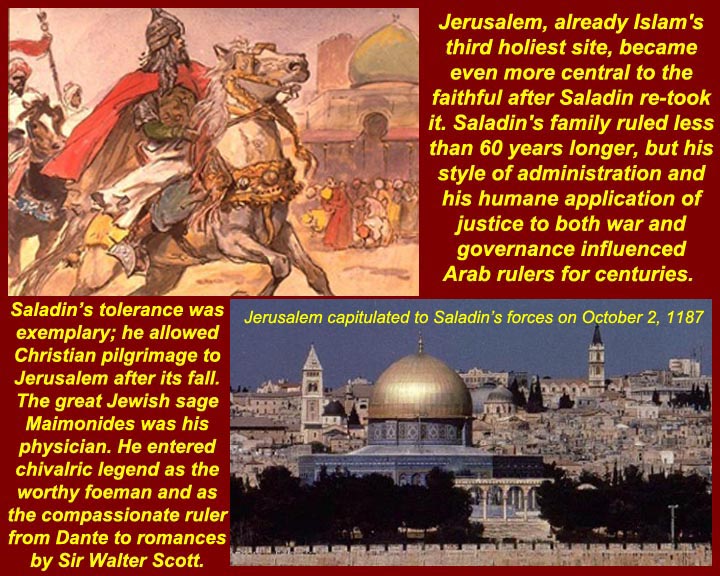
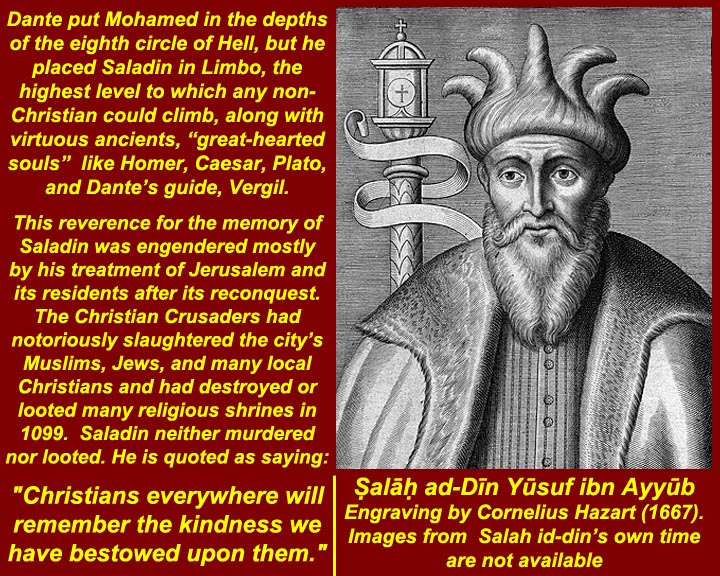
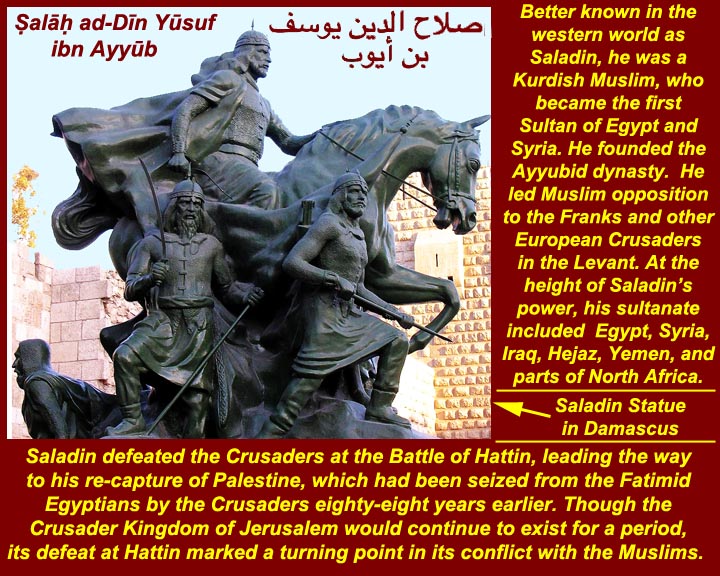
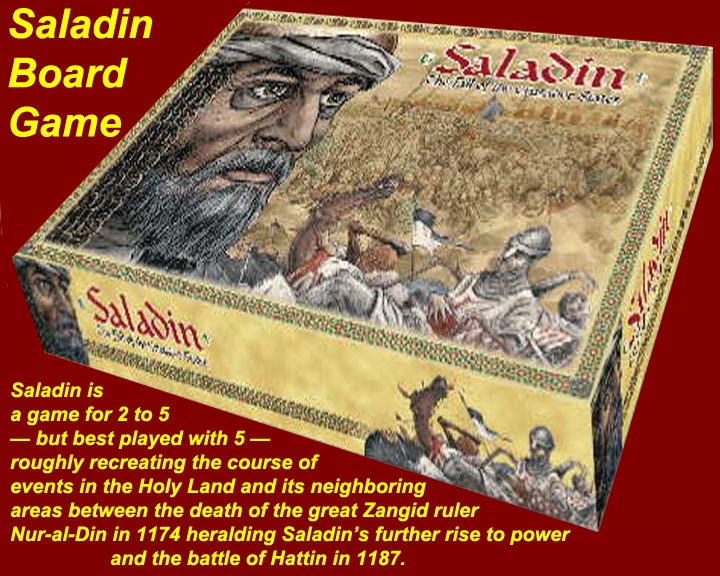
http://www.mmdtkw.org/CRUS0239-SaladinCompassionate.jpg
http://www.mmdtkw.org/CRUS0240-SaladinMerciful.jpg
http://www.mmdtkw.org/CRUS0241-SaladinStatue.jpg
http://www.mmdtkw.org/CRUS0242-SaladinGame.jpg
Salah ad-Din was an officer in one of the armies of Nur ad-Din Zengi, who had succeeded his father Imad ad-Din Zengi as the Turkic atabeg of Aleppo and Mosul. The uncle of Salah ad-Din, Asad ad-Din Shirkuh, was a General in Nur ad-Din's army, and he had been sent to Cairo to reinstate the Vizier of the Shia Fatamid Caliph. The Vizier was successfullu reinstalled, but when he tried to pay off Shirkuh and send him away, Shirkuh refused to leave. It was fairly obvious that Shirkuh's support had always been a way to exert influence and, eventually control, the Fatamid regime. Eventually a power struggle ensued. Salah ad-Din reportedly assassinated Shawar in 1169, and Shirkuh died the same year. After another shuffle of power Salah ad-Din emerged in power in Cairo. He gradually spread his power base as far north as Syria, and, after Nur ad-Din died, Salah ad-Din became the de facto ruler of all the Islamic areas. Having united the Muslims, Salah ad-Dine was finally ready to move on Jerusalem, which he finally captured in 1187.
Salah ad-Din did not repeat the kind of atrocities that the Christians had visited on Jerusalem. His good treatment of the vanquished along with his chivalrous conduct of his war against the three European king who tried to get the city back for the Christians ensured the positive reputation he enjoys with Christians and Muslims until today.
For more information on Salah ad-Din Yusuf ibn Ayyub, see http://en.wikipedia.org/wiki/Saladin.
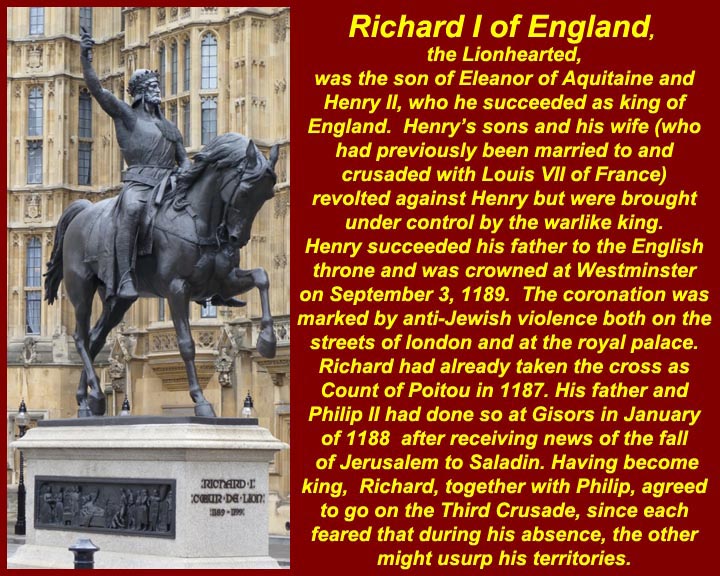
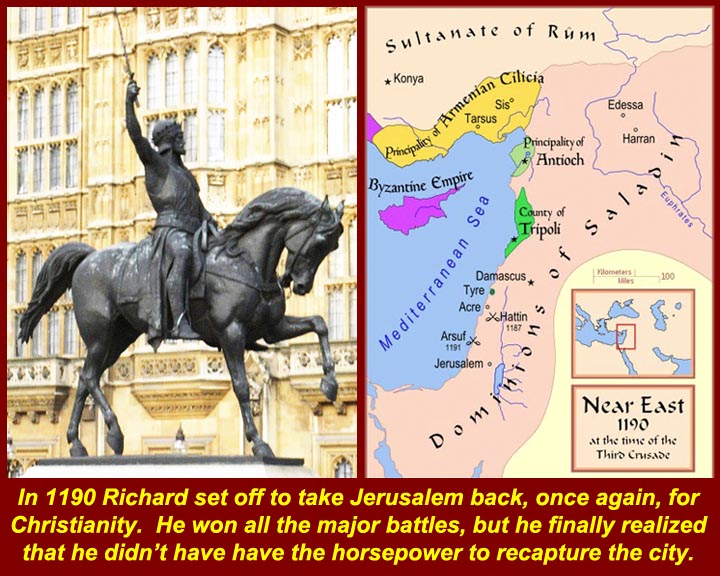
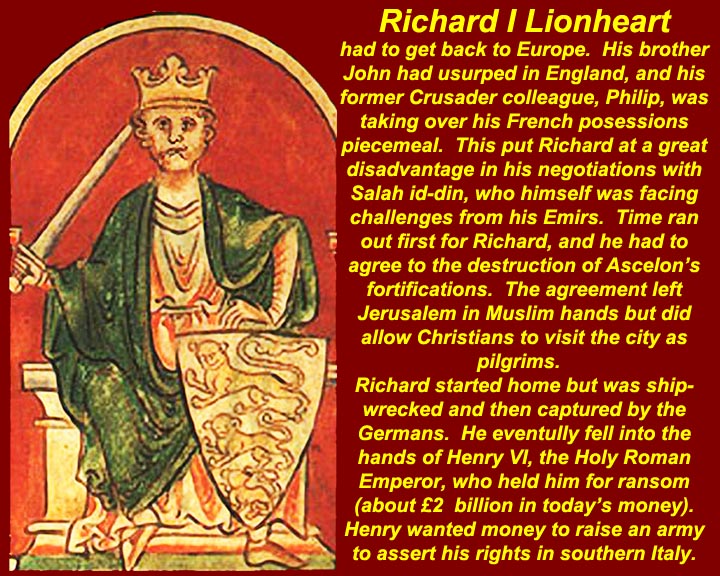
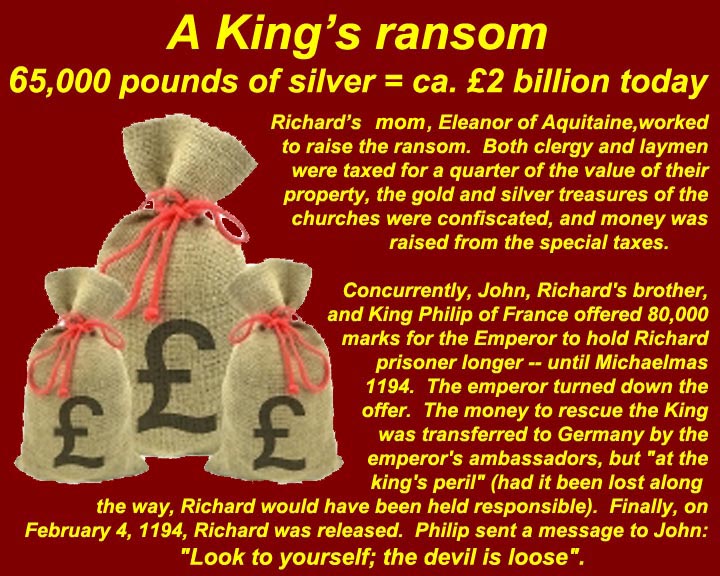
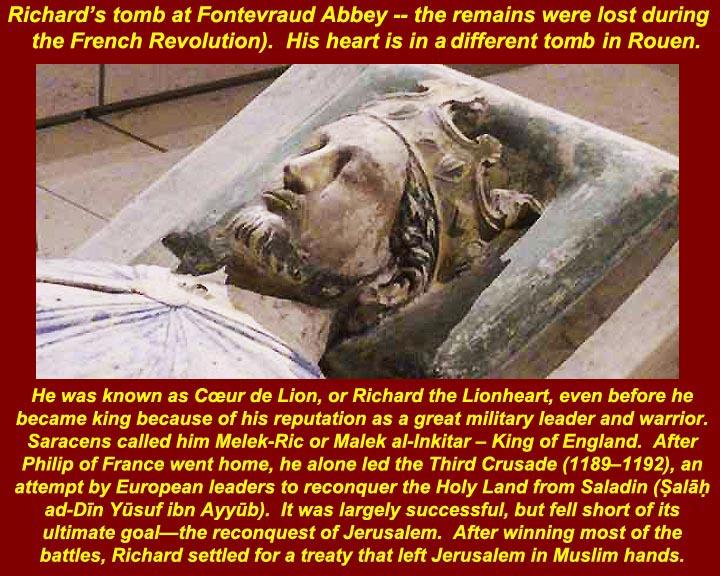
http://www.mmdtkw.org/CRUS0243-RichardLionheart1.jpg
http://www.mmdtkw.org/CRUS0244-RichardLionHeart2.jpg
http://www.mmdtkw.org/CRUS0245-RichardLionHeart3.jpg
http://www.mmdtkw.org/CRUS0246-RichardLionHeart4Ransom.jpg
http://www.mmdtkw.org/CRUS0247-RichardLionheart5Tomb.jpg
Richard Lion Heart was not one of the three kings that pledged to recover Jerusalem in the Third Crusade. It was his aged father Henry II Curt Mantle who took the cross and was to lead the English contingent. When Henry died, English participation in the Crusade was doubtful, but Richard, already a warrior of reputation with the sobriquet Lion Heart, jumped into his father's boots. Richard I was officially crowned duke on 20 July 1189 and king in Westminster Abbey on 3 September 1189.
| London pogrom at the time of Richard's coronation: When he was crowned, Richard barred all Jews and women from the ceremony, but some Jewish leaders arrived to present gifts for the new king. According to Ralph of Diceto, Richard's courtiers stripped and flogged the Jews, then flung them out of court. When a rumor spread that Richard had ordered all Jews to be killed, the people of London began a massacre. Many Jews were beaten to death, robbed, and burned alive. |
As it turned out, Richard, the substitute king in the Third Crusade was the one who famously fought Salah ad-Din to a stalemate in the Middle East.
Richard and his forces aided in the capture of Acre, despite the king's serious illness. At one point, while sick from scurvy, Richard is said to have picked off guards on the walls with a crossbow, while being carried on a stretcher. Eventually Conrad of Montferrat concluded the surrender negotiations with Saladin and raised the banners of the kings in the city. Richard quarrelled with Leopold V of Austria over the deposition of Isaac Komnenos (related to Leopold's Byzantine mother) and his position within the crusade. Leopold's banner had been raised alongside the English and French standards. This was interpreted as arrogance by both Richard and Philip, as Leopold was a vassal of the Holy Roman Emperor (although he was the highest-ranking surviving leader of the imperial forces). Richard's men tore the flag down and threw it in the moat of Acre. Leopold left the crusade immediately. Philip also left soon afterwards, in poor health and after further disputes with Richard over the status of Cyprus (Philip demanded half the island) and the kingship of Jerusalem. Richard, suddenly, found himself without allies.
Richard the Lionheart's tactical skills and military training made a huge difference in the Crusaders' capture of Acre in 1191. After the battle Richard waited impatiently for Saladin to move off from the Acre hinterland. To get things moving, Richard marched 2,700 Muslim soldiers out of Acre, onto the road of Nazareth in front of the forward positions of the Muslim army, and had them executed one by one. Saladin had for more than a month delayed fulfilling his side of the agreement that had led to the surrender of Acre and Richard meant this as a warning of what would happen if delays continued. Later, Saladin blamed Conrad of Montferrat for the atrocity.
As they came into the end game, Richard and Salah ad-din both were facing "out of theater" problems. Richard's brother, John Lack Land, was busy usurping Richard's throne in England, and Richard's erstwhile ally in the Crusade, King Phillip of France was attacking Richard's territories in France. Meanwhile, Salah ad-Din's Emirs were worse than restless after the resolve to recapture Jerusalem, which had unified Islam, had been satisfied. Richard and Salah ad-Din each knew of the other's problems, and for a while they played a waiting game: Richard hoped the Islamic coalition would break allowing him to capture Jerusalem. Salah ad-Din hoped Richard's problems in England and France would force Richard to abandon the crusade. And meanwhile small battles and skirmishes were raising the casualty rate on both sides.
Richard flinched first. He sent terms to Salah ad-Din saying that Jerusalem could stay in Muslim hands and that Richard would withdraw to Europe. The final agreement left coastal enclaves in Christian hands, and Salah ad-Din agreed the Christians could come to Jerusalem as pilgrims. (In fact Salah ad-Din had agreed to Christian pilgrimage to Jerusalem from the time he took the city, so that was not a new concession.)
Richard headed for home, but he was captured and held for ransom by the Holy Roman Emperor and his allies. The ransom was eventually paid and Richard went back to his own domain. Shortly thereafter Richard was killed in battle trying to protect his territory in France. John Lackland then legitimately succeeded Richard, but in the course of a few years all of the Plantagenet lands in France that had been gained by John's predecessors were lost to the French.
For Richard I Lion Heart, see http://en.wikipedia.org/wiki/Richard_I_of_England and numerous other Internet sites you can find by entering his name in your web browser, e.g, http://www.google.com/search?client=safari&rls=en&q=richard+lion+heart&ie=UTF-8&oe=UTF-8.
For information on the "Angevin Empire" of the Plantagenet "English" dynasty, see http://en.wikipedia.org/wiki/Angevin_Empire
| Note that some versions, especially
British and US movie versions, of the Robin Hood
folklore tales place Robin in the period of the end
of the Third Crusade and the captivity of Richard
while John Lack Land was trying to usurp Richard's
crown. There is absolutely no historical
evidence that Robin Hood was anything more than a
legend -- despite claims of several towns in
England's East Midlands that he was active
there. Note also that the scenario of the Broadway play and several movies of "The Lion in Winter" is a fiction created by author and screenwriter James Goldman about a Christmas Gathering of Henry II, his wife Eleanor, his sons, and Phillip of France. Goldman's story does, however, accurately indicate the relationship of Henry II Curt Mantle with his wife and kids and with Phillip. |
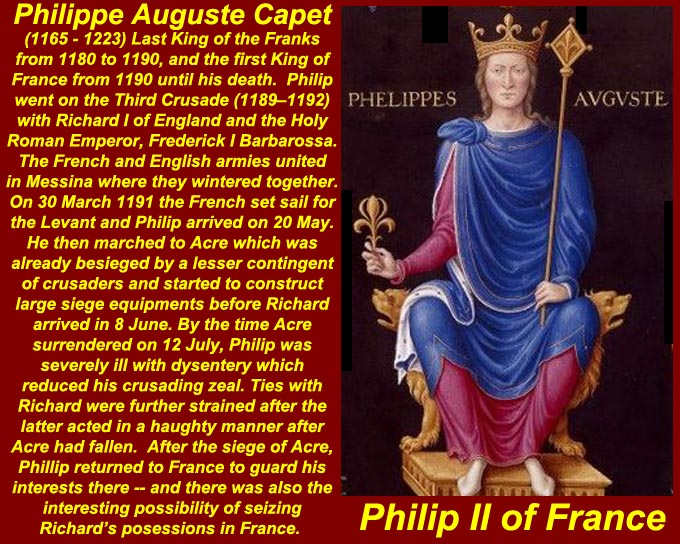
http://www.mmdtkw.org/CRUS0248-PhillipIIOfFrance.jpg
Also signed up for the Third Crusade was Phillipe II Auguste Capet the last "King of the Franks" and the first King of France. He actually arrived in the war theater first and was supervising the construction of massive siege engines at Acre when Richard arrived on June 8, 1191. By the time Acre surrendered on 12 July, Philip was severely ill with dysentery which reduced his crusading zeal. Ties with Richard were further strained after the latter acted in a haughty manner after Acre had fallen.
More importantly, the siege resulted in the death of Philip of Alsace, who held the county of Vermandois proper; an event that threatened to derail the Treaty of Gisors which Philip had orchestrated to isolate the powerful Blois-Champagne faction. Philip decided to return to France to settle the issue of succession in Flanders, a decision that displeased Richard, who said, "It is a shame and a disgrace on my lord if he goes away without having finished the business that brought him hither. But still, if he finds himself in bad health, or is afraid lest he should die here, his will be done."
Phillip left on 31 July 1191, but left a French army of 10,000 men (along with 5,000 silver marks to pay the soldiers) in Outremer under the command of Hugh III, Duke of Burgundy. Philip and his cousin Peter of Courtenay, count of Nevers, made their way to Genoa and from there returned to France. This decision to return was also fuelled by the realization that with Richard campaigning in the Holy Land, English possessions in northern France (Normandy) would be open for attack. After Richard's delayed return home after the Third Crusade, war between England and France would ensue over possession of English-controlled territories in modern-day France. Phillip eventually won and integrated under his sovereignty all the Angevin domains in France, and therefore he is called the first King of France.
Most of the above is text lifted from http://en.wikipedia.org/wiki/Philip_II_of_France#Third_Crusade where there is also much more about Phillip's wars against the Angevins after the Third Crusade..
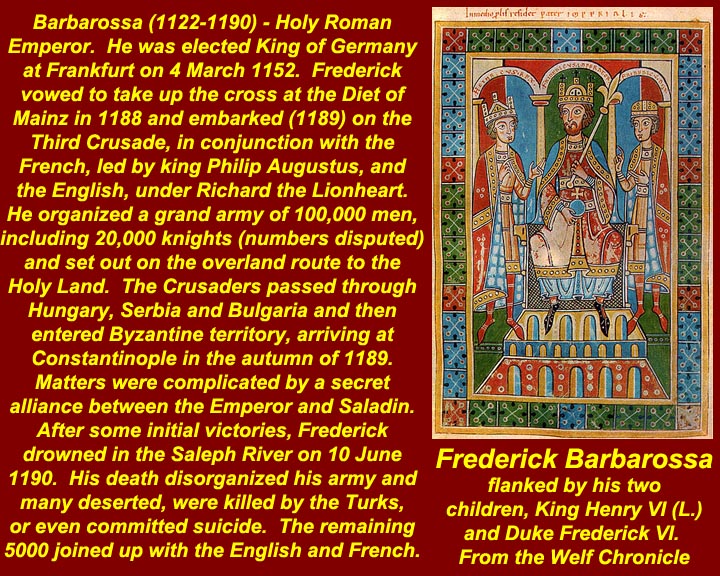
http://www.mmdtkw.org/CRUS0249-FrederickAndSons.jpg
The third king of the Third Crusade was the 67 year old Holy Roman Emperor Frederick Barbarossa. His army consisted of 100,000 men including 20,000 knights, or maybe 15,000 men and 3,000 knight, depending on who you believe. Whatever the size of his army, it caused concern among the Turks, especially after the Germans won a few victories in Anatolia. But then on June 10, 1190, Frederick got impatient, and instead of waiting to cross a crowded Saleph River (now the Goksu River), he tried to ford the river on horseback. Both he and his horse were overcome by the current and Frederick's armor took him to the bottom. His drowning distressed his troops to the point that most deserted and some even committed suicide. More were killed in harassing raids. Only 5,000 along with a small force of Hungarians who had earlier joined the German column straggled on to join the Acre siege. and that was the extent of German participation in the Third Crusade.
-----------------------------------------------------------
Fourth Crusade 1202-1204
Summaries:
http://en.wikipedia.org/wiki/Fourth_Crusade
http://www.historynet.com/fourth-crusade.htm
https://www.arlima.net/the-orb/textbooks/crusade/fourthcru.html Read this one if you want to understand the Fourth Crusade.
A complete English translation of Memoirs or Chronicle of The Fourth Crusade and The Conquest of Constantinople by Geoffrey de Villehardouin (1160-1213) is on the internet at http://www.fordham.edu/halsall/basis/villehardouin.asp.
Note that there will be a separate unit on the Fourth Crusade later in this course.
Launched in 1202, the Fourth Crusade was in part instigated by Venetian leaders who saw it as a means to increase their power and influence. Crusaders who arrived in Venice expecting to be taken to Egypt were instead diverted towards their allies in Constantinople. The great city was mercilessly sacked in 1204 (during Easter week, yet), leading to greater enmity between Eastern and Western Christians.
Timeline of the Crusades: Fourth Crusade 1198 - 1207
1198 - 1216 The power of the medieval papacy reaches its apex with the reign of Pope Innocent III (1161 - 1216) who managed to excommunicate both Holy Roman emperor Otto IV (1182 - 1218) and King John of England (c. 1167 - 1216) in 1209.
1198 - 1204 The Fourth Crusade is called to recapture Jerusalem. but it is diverted to Constantinople instead. The capital of the Byzantine Empire would be captured, sacked, and held by Latin rulers until 1261.--------------------------------------------------------------------------------------------------------
March 05, 1198 The Teutonic Knights are re-formed as a military order in a ceremony at Acre in Palestine.
August 1198 Pope Innocent III proclaims the launch of the Fourth Crusade.
December 1198 A special tax on churches is created for the purpose of funding the Fourth Crusade.
1199 A political Crusade is launched against Markward of Anweiler.
1199 Berthold, Bishop of Buxtehude (Uexküll), dies in battle and his successor Albert arrives with a new Crusading army.
February 19, 1199 Pope Innocent III issues a bull which assigns the uniform of a white tunic with a black cross to the Teutonic Knights. This uniform is worn during the Crusades.
April 06, 1199 Richard I Lionheart, king of England, dies from the effects of an arrow wound received during the siege of Chalus in France. Richard had been one of the leaders of the Third Crusade.
c. 1200 Muslim conquests in India started a decline of Buddhism in northern India, eventually resulting in its effective elimination in the nation of its origin.
1200 French nobles gather at the court of Theobald III of Champagne for a tournament. Here Fulk of Neuilly promotes the Fourth Crusade and they agree to "take the cross," electing Theobald their leader
1200 Saladin's brother, Al-Adil, takes control of the Ayyubid Empire.
1201 Death of Count Theobald III of Champagne, son of Henry I of Champagne and original leader of the Fourth Crusade. Boniface of Montferrat (brother of Conrad of Montferrat, an important figure in the Third Crusade) would be elected leader in Theobald's place.
1201 Alexius, son of deposed Byzantine emperor Isaac II Angelus, escapes from prison and travels to Europe to seek help in recovering his throne.
1201 Even while negotiating with Europeans on a price for transporting Crusader to Egypt, Venetians negotiate a secret treaty with the sultan of Egypt, guaranteeing that nation against invasion.
1202 Albert, the third Bishop of Buxtehude (Uexküll), establishes the knightly crusading order known as the Swordbrothers (also sometimes referred to as the Livonian Order, Livonian Brothers of the Sword (latin Fratres militiae Christi), the Christ Knights, or The Militia of Christ of Livonia). Mostly non-landed members of the lower nobility, the Swordbrothers are separated into classes of knights, priests, and servants.
November 1202 Christians on the Fourth Crusade arrive at Venice in the hopes of being transported by ship to Venice, but they don't have the 85,000 marks required for payment so the Venetians, under doge Enrico Dandolo, barricades them on the island of Lido until he figures out what to do with them. Eventually, he decides that they can make up the difference by capturing some cities for Venice.
November 24, 1202 After just five days of fighting, Crusaders capture the Hungarian port of Zara, a Christian city on the coast of Dalmatia. The Venetians had once controlled Zara but lost it to the Hungarians and offered passage to Egypt to the Crusaders in exchange for Zara. The importance of this port had been growing and the Venetians feared the rivalry from the Hungarians. Pope Innocent III is infuriated by this and excommunicates the entire Crusade as well as the city of Venice, not that anyone seems to notice or care.
1203 Crusaders abandon the city of Zara and move on Constantinople. Alexius Angelus, son of deposed Byzantine Emperor Isaac II, offers the Crusaders 200,000 marks and the reunification of the Byzantine Church with Rome if they capture Constantinople for him.
April 06, 1203 Crusaders launch an attack on the Christian city of Constantinople.
June 23, 1203 A fleet carrying Crusaders on the Fourth Crusade enters Bosphorus.
July 17, 1203 Constantinople, capital of the Byzantine Empire, falls to Crusading forces from Western Europe. Deposed emperor Isaac II is freed and resumes rule alongside his son, Alexius IV, while Alexius III flees to Mosynopolis in Thrace. Unfortunately, there is no money to pay the Crusaders and the Byzantine nobility are infuriated at what happened. Thomas Morosini of Venice is installed as patriarch of Constantinople, increasing the rivalry between Eastern and Western churches.
1204 Albert, the third Bishop of Buxtehude (Uexküll), gets official approval from Pope Innocent III for his Crusade in the Baltic region.
February 1204 The Byzantine nobility re-imprison Isaac II, strangle Alexius IV, and install Alexius Ducas Murtzuphlos, brother-in-law of Alexius III, on the throne as Alexius V Ducas.
April 11, 1204 After months of not being paid and infuriated at the execution of their ally, Alexius III, soldiers of the Fourth Crusade once again attack Constantinople. Pope Innocent III had again ordered them not to attack fellow Christians, but the papal letter was suppressed by clergy on the scene.
April 12, 1204 The armies of the Fourth Crusade capture Constantinople again and establish the Latin Empire of Byzantium, but not before they sack the city and rape its inhabitants for three straight days - during Easter week. Alexius V Ducas is forced to flee to Thrace. Although Pope Innocent III protests at the behavior of the Crusaders, he does not hesitate to accept a formal reunion of the Greek and Latin churches.
May 16, 1204 Baldwin of Flanders becomes the first Latin Emperor of Constantinople and the Byzantine Empire and French is made the official language. Boniface of Montferrat, the leader of the Fourth Crusade, goes on to capture the city of Thessalonica (second-largest Byzantine city) and founds the Kingdom of Thessalonica.
April 01, 1205 Death of Amalric II, king of both Jerusalem and Cyprus. His son, Hugh I, assumes control of Cyprus while John of Ibelin becomes regent for Amalric's daughter Maria for the kingdom of Jerusalem (even though Jerusalem is still in Muslim hands).
August 20, 1205 Henry of Flanders is crowned Emperor of the Latin Empire, formerly the Byzantine Empire, after the death of Baldwin I.
1206 Mongol leader Temujin is proclaimed "Genghis Khan," which means "emperor within the Seas."
1206 Theodore I Lascaris assumes the title Emperor of Nicaea. After the fall of Constantinople to the Crusaders, Byzantine Greeks spread throughout what is left of their empire. Theodore, son-in-law of the Byzantine Emperor Alexius III, sets himself up in Nicaea and leads a series of defensive campaigns against the Latin invaders. In 1259 Michael VIII Palaeologus would capture the throne and later capture Constantinople from the Latins in 1261.
May 1207 Raymond VI of Toulouse (descendant of Raymond IV or Toulouse, a leader of the First Crusade) refuses to assist in the suppression of the Cathars in southern France and is excommunicated by Pope Innocent III.
September 04, 1207 Boniface of Montferrat, leader of the Fourth Crusade and founder the Kingdom of Thessalonica, is ambushed and killed by Kaloyan, Tsar of Bulgaria.
click on small images or on links to increase image size.
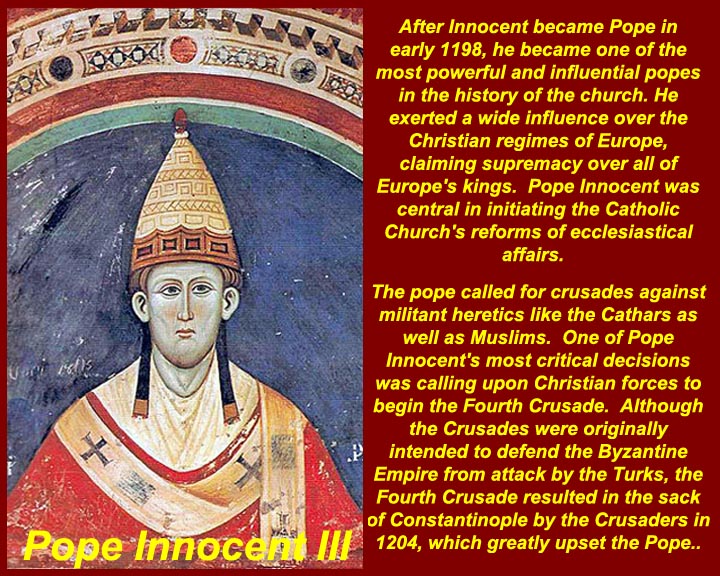
http://www.mmdtkw.org/CRUS0250-InnocentIII.jpg
Innocent III was a young and active pope, only thirty-eight when elected. He used the interdict and other forms of pressure to line up European monarchs behind his decrees and ecclesiastic reforms and, eventually, behind his idea that yet another Crusade was needed to carry out the failed missions of the Second and Third Crusades. Unlike his predecessors, Innocent did not want kings to lead the Fourth Crusade, but he did demand that European disputes between monarchs and among cities had to stop to free up knights and people to once again march / sail off to the Middle East. But before sending the folks eastward, he organized a "Crusade" against the Albigensian (Cathar) heretics in southwestern France.
| The 1208 murder of Pierre
de Castelnau, a papal representative in Albigensian
territory, changed Innocent's focus from words to
weapons. Innocent called upon King Philip II Augustus of
France to suppress the Albigenses. Under the leadership
of Simon de Montfort, 5th Earl of Leicester, a campaign
was launched. The Albigensian Crusade, which led to the
brutal slaughter of approximately 20,000 men, women and
children, Cathar and Catholic alike essentially
destroyed the previously flourishing civilization of
Occitania and brought the region firmly under the
control of the king of France. It was directed not only
against heretical Christians, but also the nobility of
Toulouse and vassals of the Crown of Aragon. King Peter
II of Aragon, "the Catholic," was directly involved in
the conflict, and was killed in the course of the Battle
of Muret in 1213. The conflict largely ended with the
Treaty of Paris of 1229, in which the integration of the
Occitan territory in the French crown was agreed to.
Military action ceased in 1255. (From http://en.wikipedia.org/wiki/Pope_Innocent_III#Crusades_and_suppression_of_heresy. |
Then, on to the Crusade: Innocent, also unlike his predecessors, thought he would lead the Fourth Crusade himself. An imaginative use of taxes (including on churches and the clergy -- unheard of before) and a "buy out" plan under which former and future "crusaders" could pay their way out of their vows were used to raise funds. The initial destination of the Fourth Crusade would be Egypt with follow on plans to use Egypt as a base, from which to capture of Jerusalem.
Any attack on Egypt would require ships. The Venetians were ready to supply them for the usual fee.
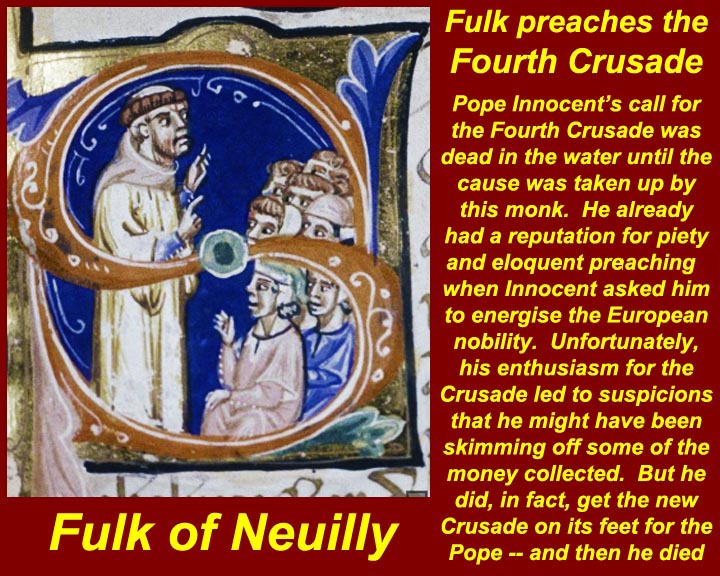
http://www.mmdtkw.org/CRUS0252-Fulk_of_Neuilly.jpg
Every Crusade needs a monkish preacher, and the Fourth Crusade needed one more than most. Pope Innocent's crusade went nowhere until Fulk of Neuilly began took to pulpits around Europe calling on nobles, people, cities, and communities to join in the effort. Even before he took up this cause , he was well known for his eloquence and persuasiveness. His enthusiasm led some critics to question whether he might have ulterior motives, especially concerning the funds he was collecting. But there was no doubt that it was Fulk who got the Fourth Crusade on its way -- and then he died.
For more information, see http://www.newadvent.org/cathen/06157a.htm.
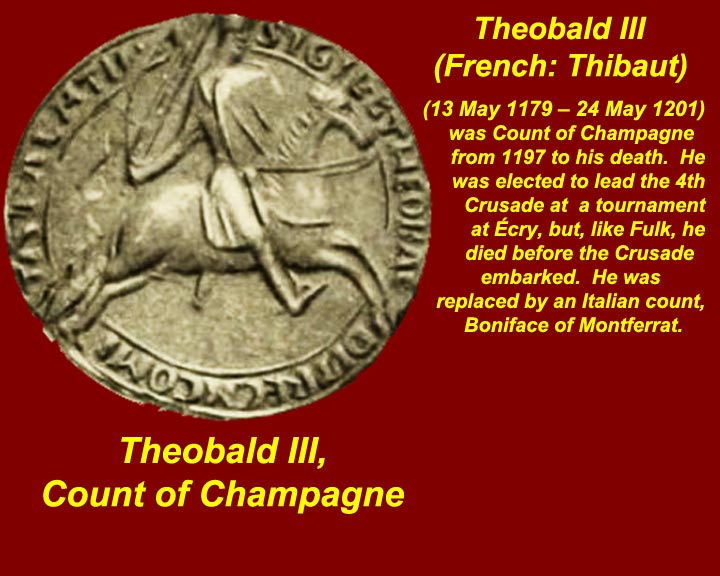
http://www.mmdtkw.org/CRUS0253-ThibaufIII_1198.jpg
At an 1198 tournament at his Ecry sul-Aisne castle, Theobald (Thibaut) III, Count of Champagne, was elected to lead the Fourth Crusade. Theobald was the younger son of Henry I of Champagne and Marie, a daughter of Louis VII of France and Eleanor of Aquitaine. Fulk was there. Before the Crusade could launch, however, he married and died. He apparently spent some time with his wife. His widow ran Champagne for the next twenty-one years as regent for his posthumous son. Although he did not lead the Crusade, he is remembered for providing an army, a fleet, and, most importantly, money. The inscription on his tomb reads:
Intent upon making amends for the injuries of the Cross and the land of the Crucified
He paved a way with expenses, an army, a fleet.
Seeking the terrestrial city, he finds the one celestial;
While he is obtaining his goal far away, he finds it at home.
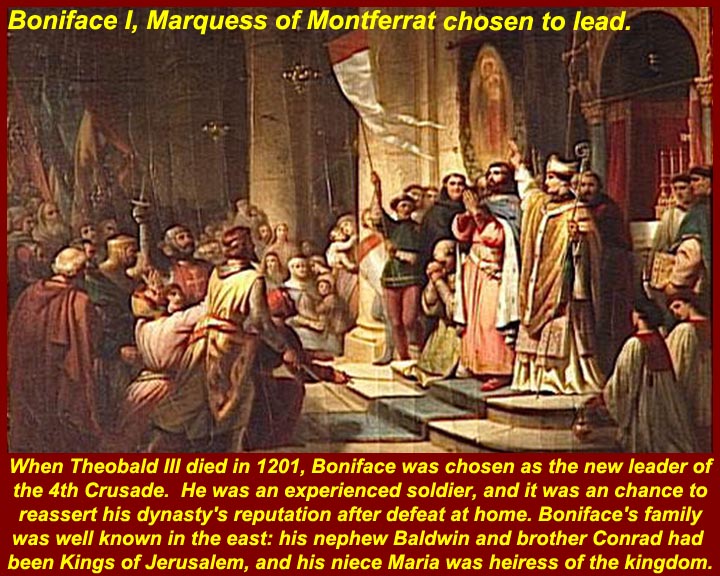
http://www.mmdtkw.org/CRUS0254-Boniface-of-Montferrat.jpg
The next man chosen to Lead the Crusade was Boniface I of Montferrat, seen in the image being blessed before setting off.
From http://en.wikipedia.org/wiki/Boniface_I,_Marquess_of_Montferrat:
Boniface's cousin Philip of Swabia was married to Irene Angelina, a daughter of the deposed Byzantine emperor Isaac II Angelus and niece of Conrad's second wife Theodora. In the winter of 1201 Boniface spent Christmas with Phillip in Hagenau, and while there also met with Alexius Angelus, Isaac II's son, who had escaped from the custody of his uncle Alexius III Angelus. At this time the three discussed the possibility of using the crusading army to restore Alexius' right to the throne. Both Boniface and Alexius traveled separately to Rome to ask for Pope Innocent III's blessing for the endeavour; however, Boniface was specifically told by Innocent not to attack any Christians, including the Byzantines.
The Crusader army was in debt to the doge of Venice, who had provided their fleet. He instructed them to attack the rebellious cities of Trieste, Moglia, and Zara and beat them into submission before sailing for Cairo. The Pope was angered by these Christian cities being attacked by a Crusader army. The doge, Enrico Dandolo, was now the true war leader of this Crusade, with Boniface as only a figurehead. Alexius Angelus made many promises to the Crusaders and their principal financier, the doge of Venice, for riches and honors if they would help him reclaim his kingdom. Dandolo placated the Pope by having Alexius Angelus promise to submit the Orthodox Church to Rome when he was restored to his throne in Constantinople. This being done, the fleet set sail for Constantinople in 1203.
After the conquest of Constantinople in 1204, Boniface was assumed to be the new emperor, both by the western knights and the conquered Byzantine citizens. However, the Venetians vetoed him, believing that he already had too many connections in the Empire (and, likely, felt that they would not have as much influence in the new Empire if Boniface was in control). Instead, they chose Baldwin of Flanders. Boniface founded the Kingdom of Thessalonica and also held all the territories lied east of Bosporus and territories in Crete, though he later conceded Crete to Baldwin. Late 13th and 14th century sources suggest that Boniface based his claim to Thessalonica on the statement that his younger brother Renier had been granted Thessalonica on his marriage to Maria Komnene in 1180.
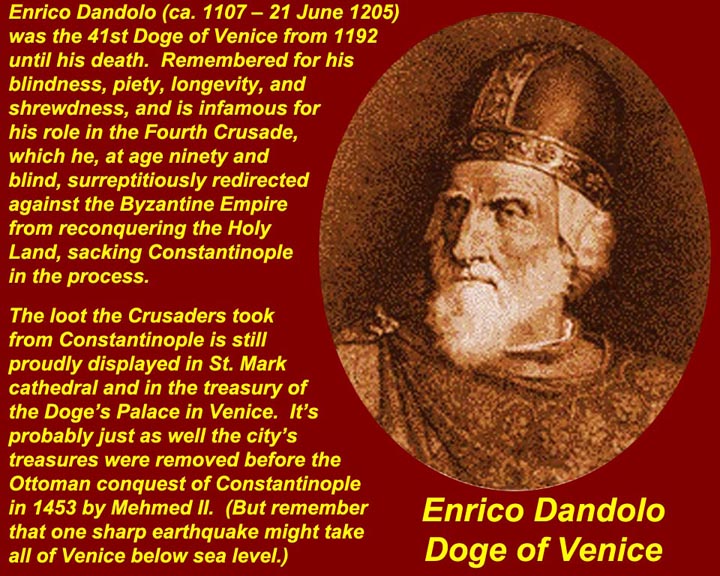
http://www.mmdtkw.org/CRUS0255-DogeEnricoDandolo.jpg
The 41st Venetian Doge, old, blind, pious, and greedy Enriico Dandolo, is universally vilified as the evil genius of the Fourth Crusade. Despite explicit commands from Pope Innocent III that no Christian cities were to be attacked, Dandolo used financial leverage to direct the crusaders to restore Zadar on the Adriatic to Venetian control. Dandolo then agreed to lead the Crusaders to Constantinople to intervene in that city's internal politics. The crusaders did manage to put Alexios Angelos, the deposed Emperor Isaac II back on the throne, but Isaac and his son Alexios couldn't or wouldn't pay what Alexios had promised for the service. When Alexios defied Doge Dandolo's threats, Dandolo directed the sack of Constantinople. The Venetians carried off treasures, relics, the four bronze quadriga horses that decorated the hippodrome, and most importantly, loads of cash. The division of the spoils also gave Venice three-eights of the former Byzantine territories (much of which they influenced until the next wave of Turkish conquests which began in the 15th century.)
For more information on Doge Enrico Dandolo, see http://en.wikipedia.org/wiki/Enrico_Dandolo and http://www.newadvent.org/cathen/04619a.htm.
For the siege of Constantinople, see http://en.wikipedia.org/wiki/Siege_of_Constantinople_(1204)
For on the spot accounts of the sack 0f Constantinople in 1294, see http://www.fordham.edu/halsall/source/4cde.asp.
